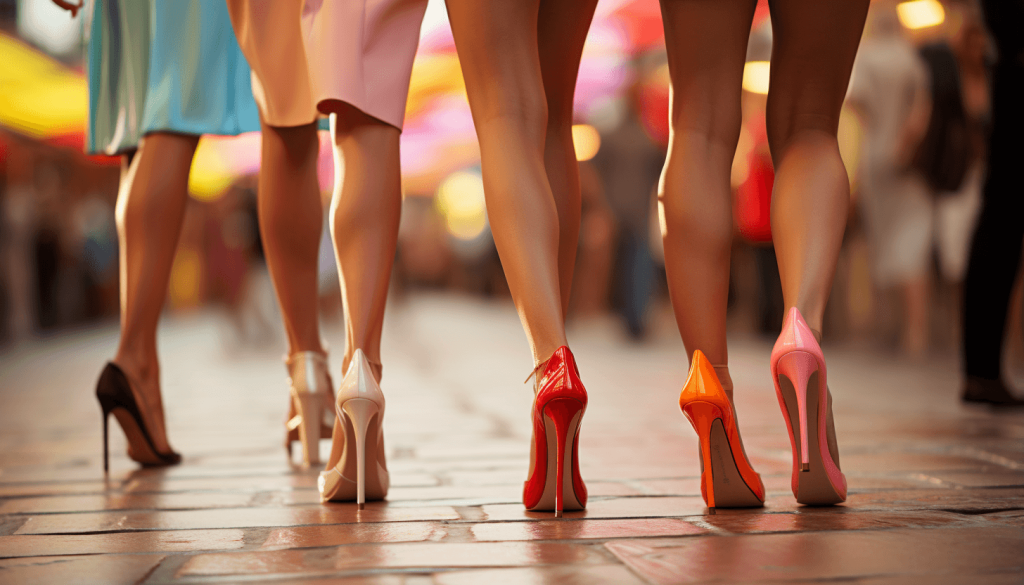| 1. Stiletto | 2. Kitten | 3. Block |
| 4. Wedge | 5. Espadrille | 6. Cone |
| 7. Spool | 8. Platform | 9. Slingback |
| 10. Ankle Strap | 11. Mule | 12. Peep Toe |
| 13. T-strap | 14. Mary Jane | 15. Pump |
| 16. Ballet | 17. High Heel Sandal | 18. Cork High Heel |
| 19. Oxfords | 20. Cut-out | 21. Gladiator |
| 22. D’Orsay | 23. Ballroom | 24. Cuban |
| 25. Prism | 26. Fantasy | 27. Flared |
| 28. French | 29. Comma | 30. Blade |
The Evolution of Heel Fashion: A Historical Overview
Heels, a fashion statement that has transcended time, cultures, and geographies, have always been more than just footwear. With roots that dive deep into our past, heels have played both functional and aesthetic roles, evolving through centuries to become a symbol of style, power, and sophistication.
Origin: More Than Just Style
The history of heels can be traced back to ancient civilizations. The Egyptians wore platforms to differentiate the social classes, while in Ancient Greece, actors wore heels as a representation of their status in society.
The Renaissance & Beyond
- 16th Century: The elevated shoe, or chopine, made from cork or wood, became popular in Venice. Worn by women, it symbolized the wealth and status of the wearer.
- 17th Century: King Louis XIV of France popularized red heels, making them exclusive for his court members, signifying nobility.
- 18th Century: As the century progressed, the heel began to differentiate into the masculine and feminine styles we recognize today.
Modern Twists
With the advent of the 20th century, designers such as Salvatore Ferragamo and Christian Dior began to play with heel height and styles, giving birth to many of the popular heel types we adore today, from stilettos to wedges.
Today, heels continue to be a blend of form and function, standing as a testament to the wearer’s style, choice, and at times, their status. As we step into the next segment, we’ll delve into the myriad of heel types that grace the world of fashion, offering both elegance and empowerment with every step.
Elevate Your Style: A Comprehensive Guide to Different Heel Types
Stiletto
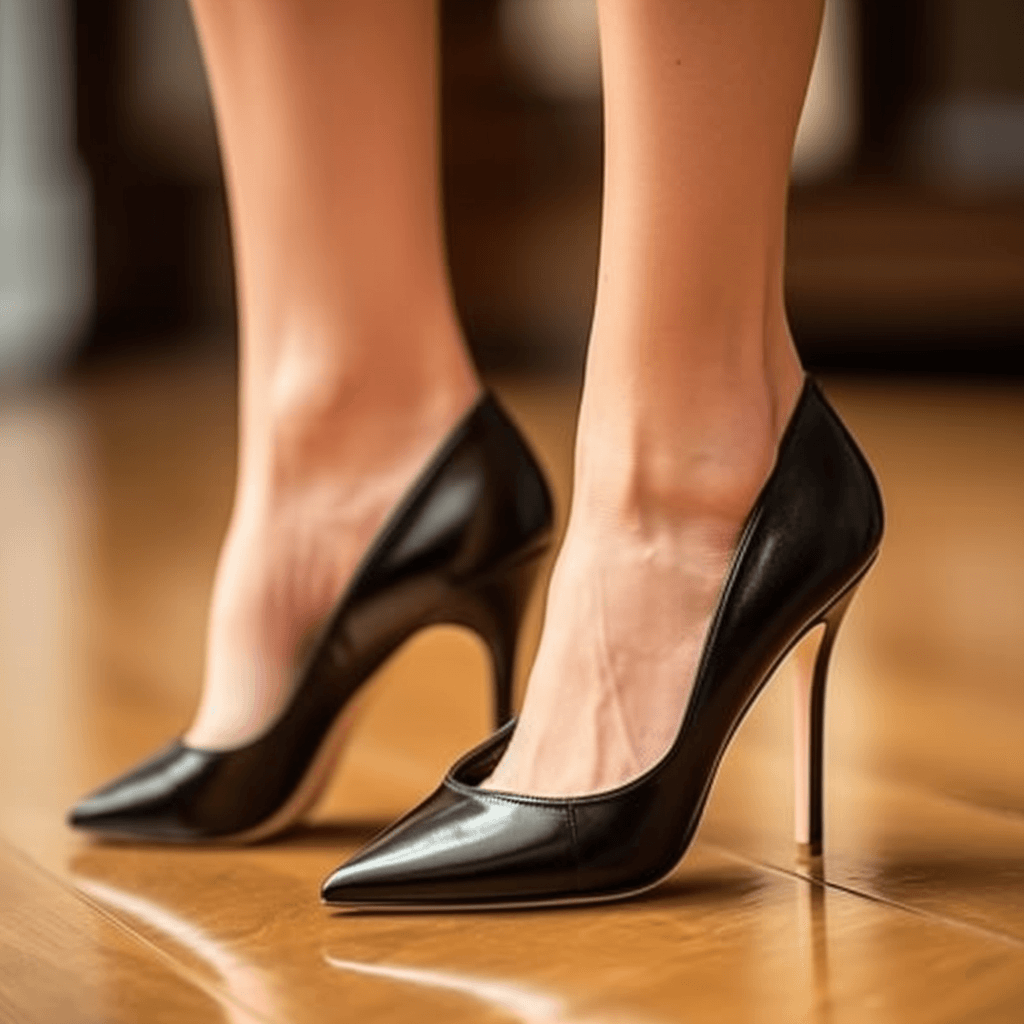
The stiletto is the epitome of high-fashion heels, characterized by a tall and slender heel that can reach up to 10 inches. While they offer an unmatched elegance and a heightening effect, they might require some practice to walk in comfortably.
Historical Origin: The stiletto, known for its dagger-like heel, traces its name back to the Italian ‘stiletto’ knife. Its popularity soared in the 1950s and became the symbol of femininity and sophistication.
Distinctive Features: Defined by its thin and tall heel, stilettos can reach heights of up to 10 inches, although most are between 2 to 10 inches.
Popular Wear Occasions: Perfect for formal occasions, cocktail parties, and date nights. They’re a favorite on the red carpet too!
Styling Tips: Best paired with evening dresses, pencil skirts, and even skinny jeans for a touch of glam.
Comfort Level: Given their height and thinness, they might be challenging for extended wear but are loved for the elegance they bring.
Variations & Subtypes: They come in various styles, including pointed, peep toe, and ankle strap stilettos.
Celebrities & Icons: Marilyn Monroe, Sarah Jessica Parker, and Victoria Beckham are a few celebrities who’ve embraced the stiletto trend over the years.
Kitten
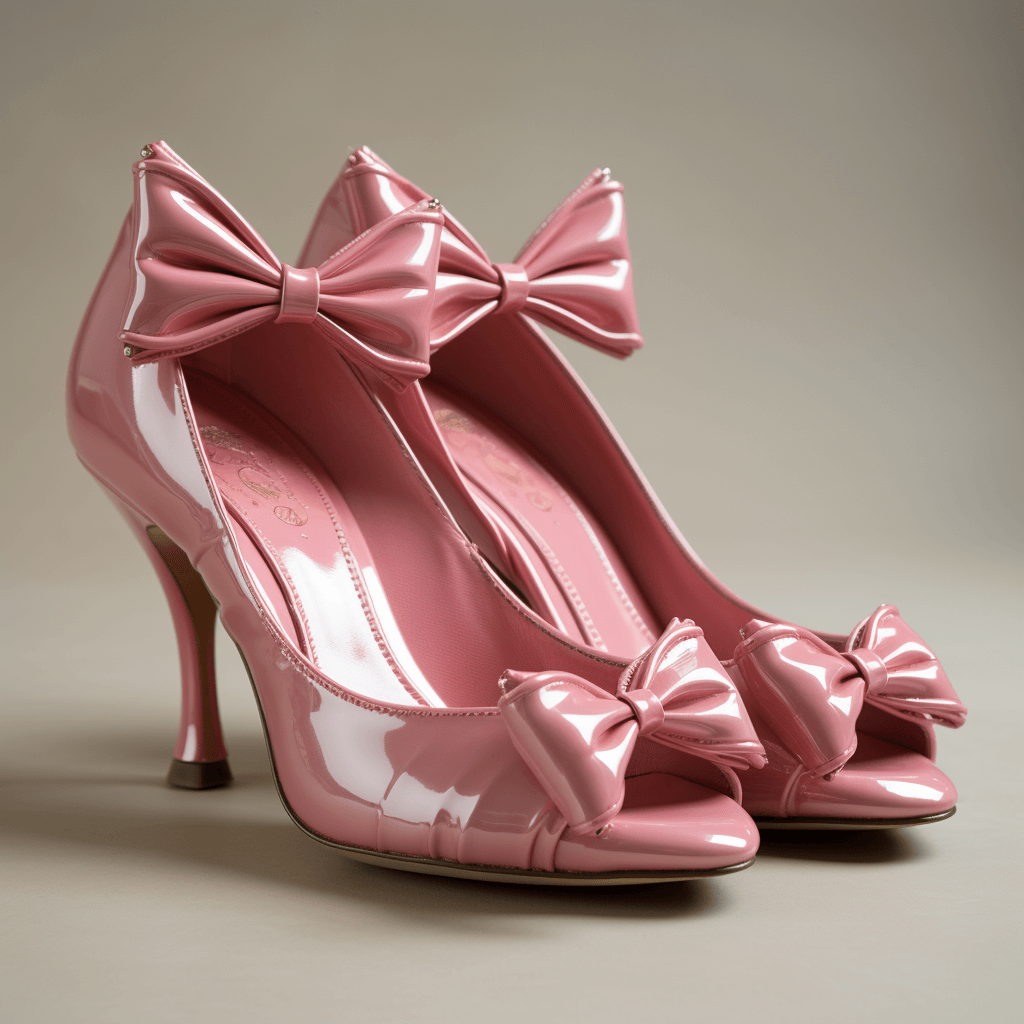
The kitten heel is a modest alternative to the stiletto, boasting a short and slender heel that usually measures between 1.5 to 2 inches. It’s a perfect choice for those seeking a touch of sophistication without sacrificing too much comfort.
Historical Origin: Kitten heels emerged in the late 1950s as a modest alternative to stilettos, especially for younger women not ready for sky-high heels yet.
Distinctive Features: These are characterized by their short, slender heel, usually from 1.5 inches to 2 inches high.
Popular Wear Occasions: Ideal for work settings, casual outings, and events where comfort is key.
Styling Tips: Works beautifully with midi skirts, A-line dresses, and even cropped pants. They give a touch of sophistication without compromising comfort.
Comfort Level: Given their shorter heel, kitten heels are generally more comfortable for prolonged wear.
Variations & Subtypes: The modern kitten heel comes in slingback, mule, and pointed-toe styles, among others.
Celebrities & Icons: Audrey Hepburn famously wore kitten heels, and more recently, Michelle Obama and Taylor Swift have showcased their love for this heel type.
Block
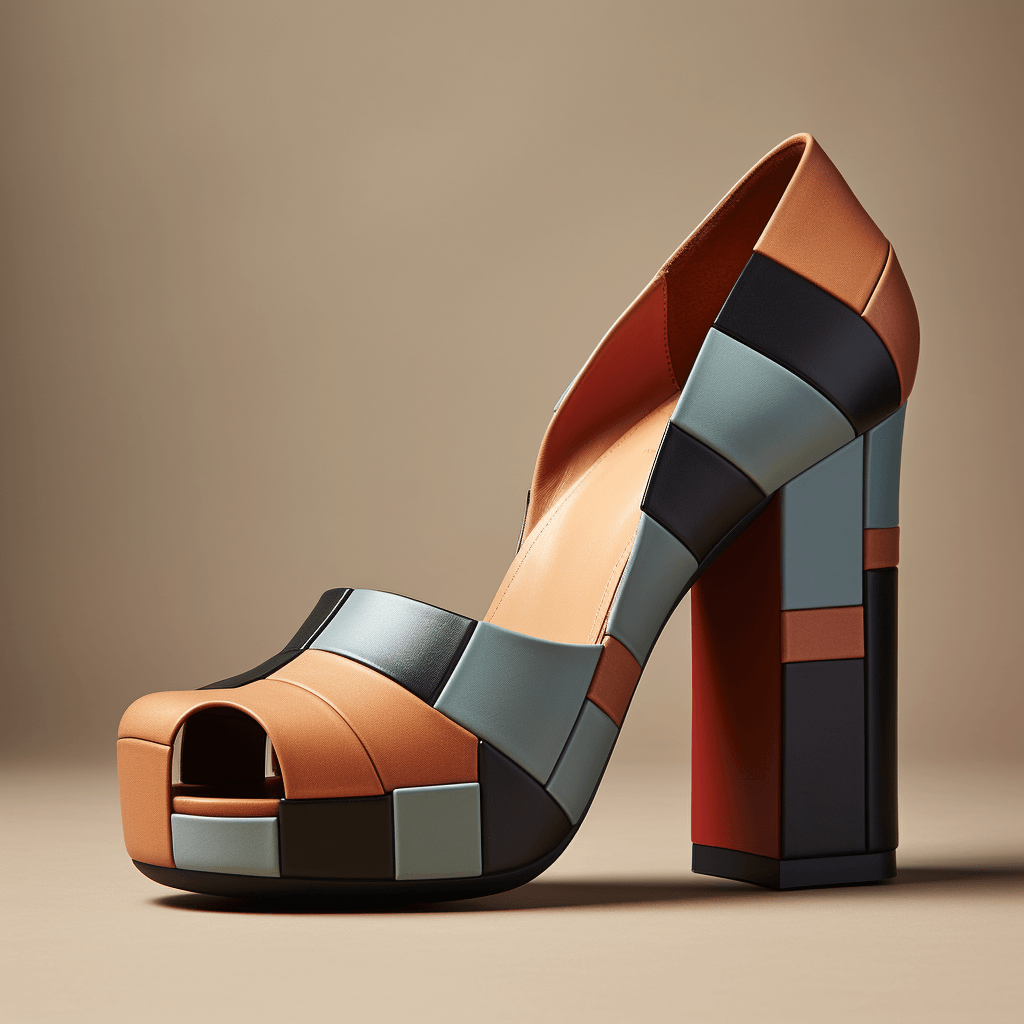
The block heel, with its thick and squared base, offers a contemporary look. Its broader surface area means it provides more stability than some other heel types, making it a popular choice for day-to-day wear.
Historical Origin: The block heel made its significant appearance in the 1960s and 1970s. It was a response to the demand for more stable footwear compared to the stiletto, and it soon became the staple of the disco era.
Distinctive Features: As the name suggests, block heels have a thicker base. This squared bottom holds maximum weight and offers stability.
Popular Wear Occasions: Block heels are versatile. They are apt for office settings, casual outings, and even some formal events.
Styling Tips: These heels pair well with almost everything – from jeans and shorts to dresses and skirts. They’re especially trendy with bohemian dresses and wide-legged pants.
Comfort Level: The wide base provides more surface area, making them considerably comfortable for extended wear.
Variations & Subtypes: Block heels come in various styles, including sandals, boots, and mules.
Celebrities & Icons: Celebrities like Selena Gomez and Kate Middleton have been spotted flaunting block heels on numerous occasions.
Wedge
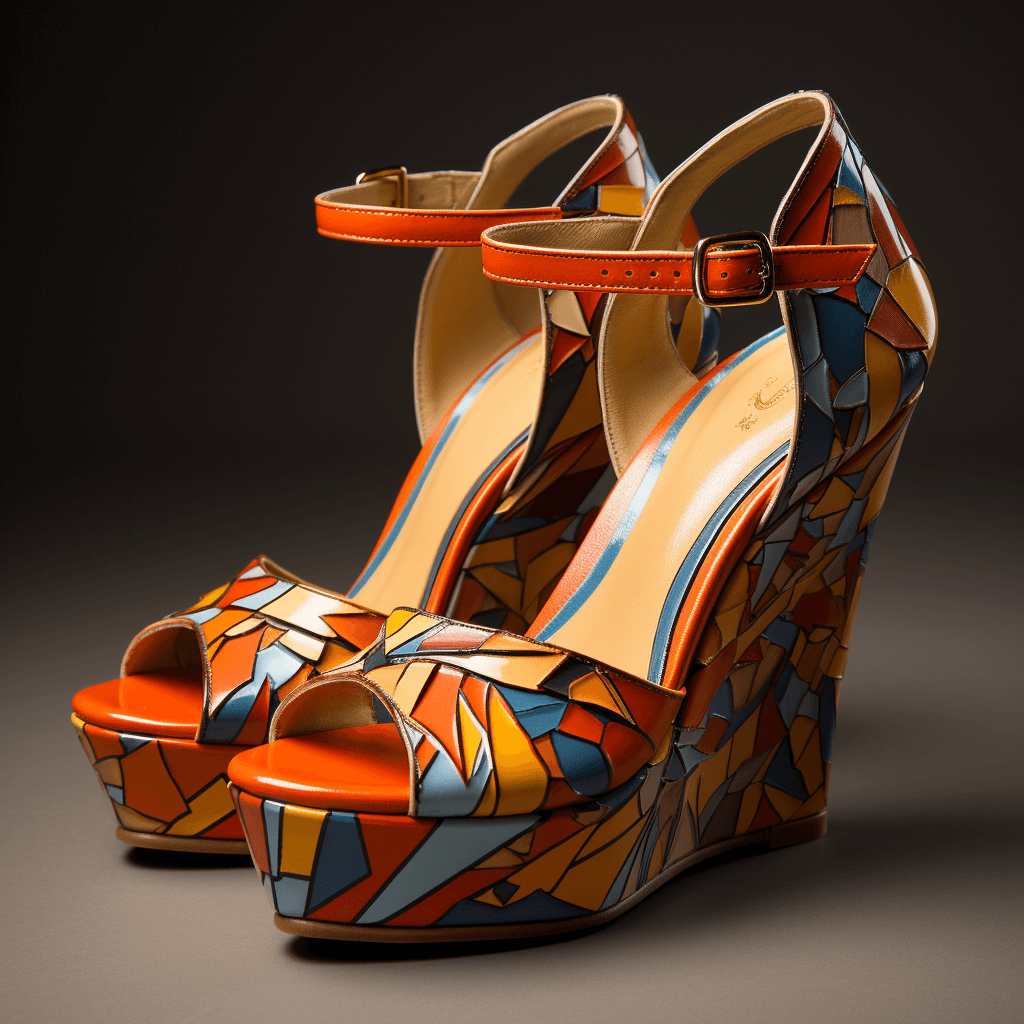
Distinctive in design, the wedge heel extends from the back of the shoe to the middle or front, forming a wedge shape. This design offers height without the distinct separation of heel and sole, making it a stylish yet comfortable choice for many.
Historical Origin: The wedge heel has been around since the early 20th century, but it gained massive popularity in the 1970s. Its design is credited to Italian designer Salvatore Ferragamo, who created the wedge due to the leather shortage during World War II.
Distinctive Features: Unlike traditional heels, where the heel is under the back of the foot, wedges run under the shoe, from the back of the shoe to the middle or front.
Popular Wear Occasions: Wedges are summer favorites and are perfect for beach vacations, picnics, and casual outings. They are also a popular choice for garden parties and outdoor events because they don’t sink into the grass like stilettos.
Styling Tips: They are best paired with summer dresses, skirts, and shorts. A pair of wedges with jeans can give a casual outfit a polished look.
Comfort Level: Due to their design, wedges offer more surface area and are thus more comfortable than traditional high heels.
Variations & Subtypes: They come in different styles, from espadrille wedges (with a jute or straw base) to cork wedges and more.
Celebrities & Icons: Hollywood icons like Marilyn Monroe and Sophia Loren have been fans of the wedge heel. In contemporary times, actresses like Reese Witherspoon and Blake Lively have been seen rocking them.
Espadrille
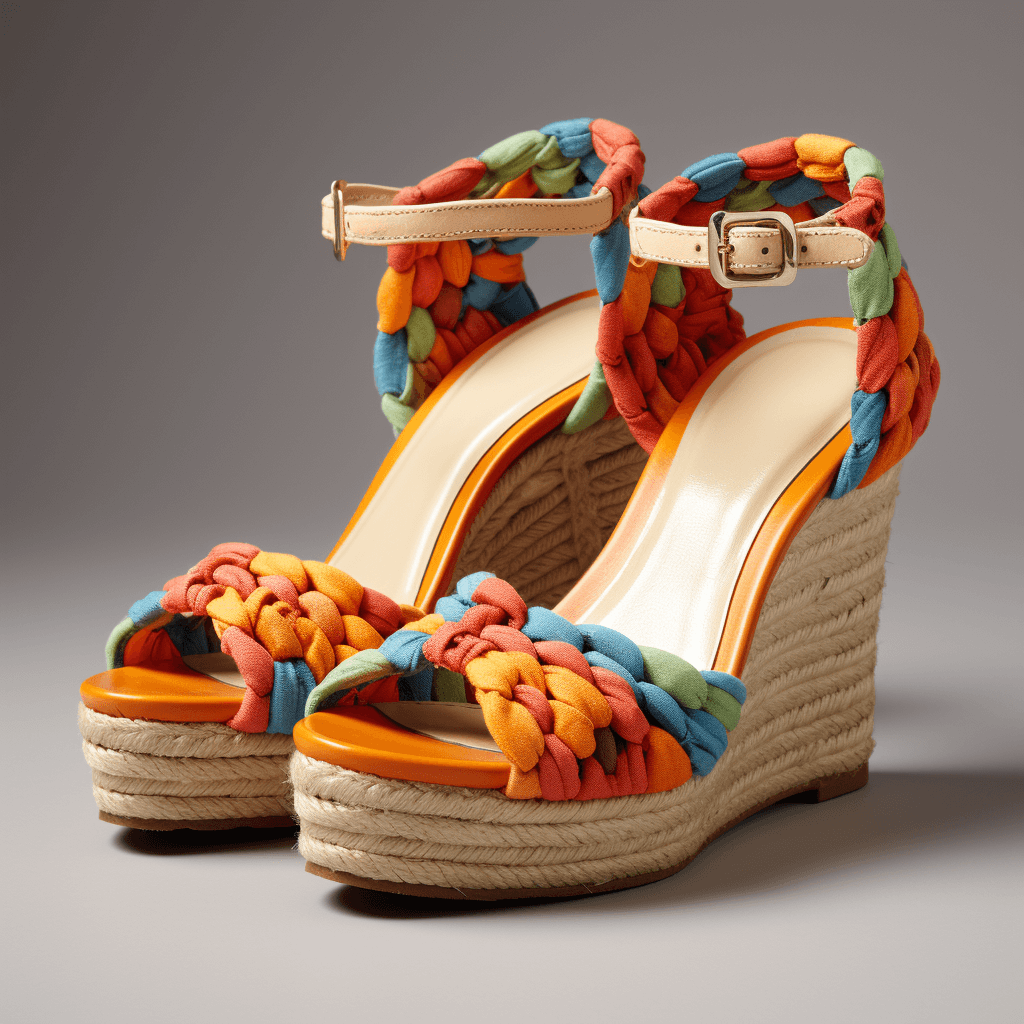
A summer favorite, the espadrille heel is a type of wedge made from braided jute or straw. Its design is reminiscent of beach vacations and is often paired with casual outfits, offering a relaxed yet chic look.
Historical Origin: Espadrilles, with their iconic jute sole, trace their roots back to the Pyrenees region between Spain and France. They have been made in Catalonia since the 14th century and have been worn by both peasants and soldiers.
Distinctive Features: Espadrilles are defined by their braided jute or straw sole. They might be flat or have a heel, and are usually made of canvas or cotton fabric for the upper part.
Popular Wear Occasions: Being synonymous with summer, they’re perfect for beach outings, vacations, and casual summer strolls.
Styling Tips: Espadrilles pair beautifully with sundresses, shorts, and even jeans. For a chic summer look, try them with a flowy maxi dress or a midi skirt.
Comfort Level: Espadrilles offer a good level of comfort, especially the flat ones. The heeled variety can be comfortable too, depending on the height and design.
Variations & Subtypes: While traditional espadrilles are flat, heeled variations have become trendy. There are also slip-on versions and those with ankle ties.
Celebrities & Icons: Brigitte Bardot popularized espadrilles in the 1950s. Modern celebrities like Jennifer Aniston and Kate Middleton have been spotted wearing them during summer outings.
Cone
As the name suggests, the cone heel has a wider base that tapers to a narrower point, resembling an ice cream cone. It’s a playful and stylish choice that offers more stability than a stiletto due to its broader base.
Historical Origin: The cone heel, with its broad base that narrows as it reaches the sole, began gaining traction in the 1950s and 1960s. It was a fresh alternative to the stilettos of that era.
Distinctive Features: Shaped like an ice cream cone, these heels are wider at the sole and taper down, offering a unique silhouette.
Popular Wear Occasions: Cone heels are versatile and can be worn to work, casual outings, and even more formal occasions.
Styling Tips: These heels work well with both dresses and trousers. A pair of cone heeled sandals can elevate a simple jeans-and-top combo.
Comfort Level: Due to their wider base, they offer more stability than stilettos, making them relatively comfortable for extended wear.
Variations & Subtypes: Cone heels are seen on various shoe types, from boots and pumps to sandals.
Celebrities & Icons: Icons like Audrey Hepburn embraced the cone heel during the 1960s. Today, stars like Taylor Swift and Emma Stone have embraced this vintage-inspired style.
Spool
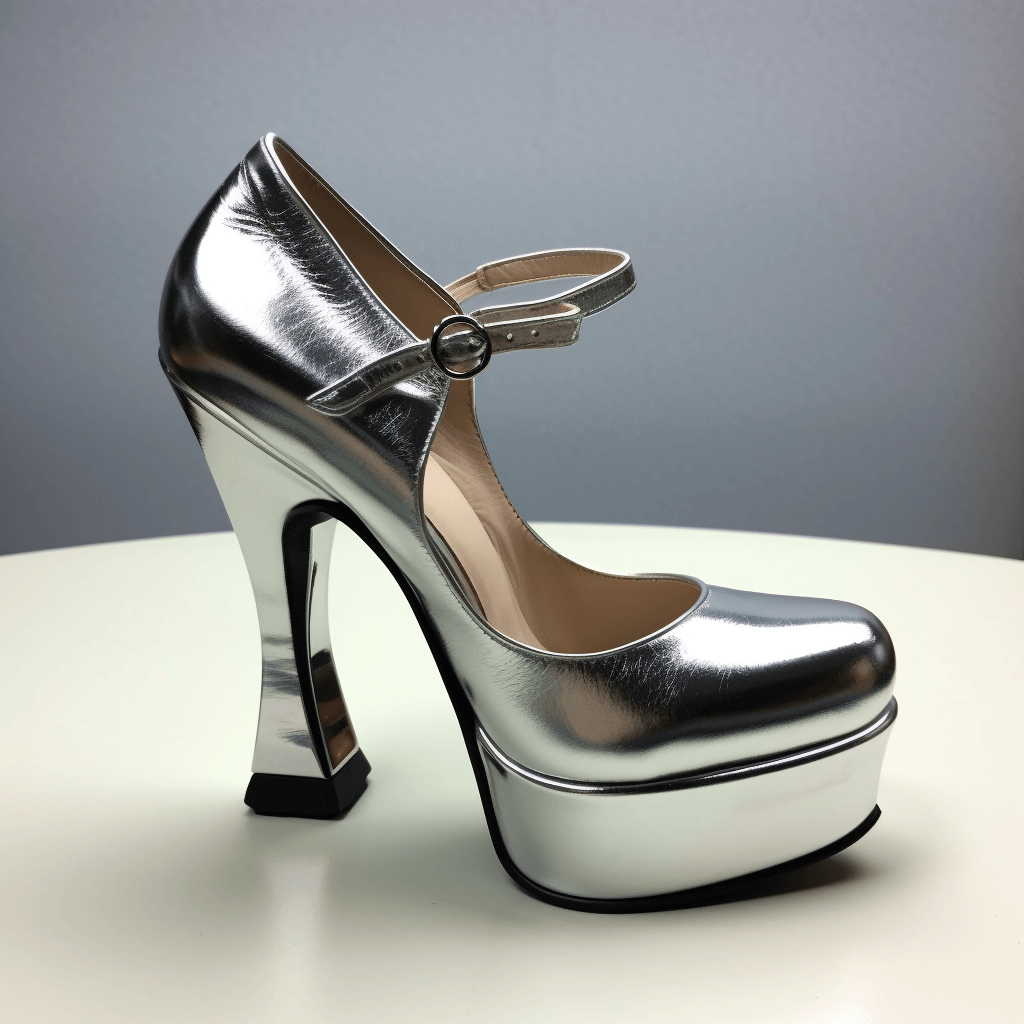
The spool heel, also known as a Louis heel, has a broader top and bottom with a narrower middle, creating an hourglass shape. It’s a vintage style that has made a comeback in modern fashion, offering both elegance and comfort.
Historical Origin: The spool heel, also known as the Louis heel due to its association with King Louis XIV of France, dates back to the 17th century. It gained popularity in Europe, especially during the Baroque and Rococo periods.
Distinctive Features: Characterized by a broader top and bottom with a narrowed middle, the spool heel presents an hourglass shape which sets it apart from other heel types.
Popular Wear Occasions: Given its classic nature, spool heels are versatile, making them suitable for office settings, formal events, or even casual outings.
Styling Tips: Perfect with vintage dresses for a retro look or with modern attire for a touch of classical elegance. They can also be paired with tailored trousers for a sophisticated ensemble.
Comfort Level: The spool heel offers a good balance between height and stability, granting a more comfortable experience compared to very high or very thin heels.
Variations & Subtypes: While traditional spool heels are mid-height, contemporary versions can range from shorter to taller, appearing on various shoe styles.
Celebrities & Icons: Actresses from Hollywood’s Golden Age, such as Grace Kelly and Audrey Hepburn, often wore shoes with spool heels, reflecting the elegance of the time.
Platform
Platform heels come with a thick sole under the front part of the foot along with a heel that can be of any style – stiletto, block, etc. They offer added height without the steep arch, making them more comfortable for extended wear.
Historical Origin: Platforms have a rich history, with evidence suggesting their use in ancient Greece to boost the height of important figures. They became a fashion statement during the 1970s disco era.
Distinctive Features: Platforms stand out due to the thick sole beneath the front part of the foot, combined with any style of heel at the back, often elevating the entire shoe.
Popular Wear Occasions: Once a staple of disco and dance clubs, platforms have made a resurgence and can be seen at parties, concerts, and fashion events.
Styling Tips: They pair well with flared pants, miniskirts, and even formal dresses for those looking to add extra height. Remember to practice walking in them to navigate with confidence!
Comfort Level: Platforms provide added height without putting excessive strain on the arch, making them more comfortable than heels of equivalent height. However, due to their height, one should be cautious while walking.
Variations & Subtypes: From platform sandals to platform boots, the thick sole characteristic can be combined with various shoe styles and heel types.
Celebrities & Icons: Elton John and the Spice Girls are among the famous figures who’ve embraced platforms. Today, stars like Lady Gaga and Rihanna frequently don platform heels, showcasing their enduring appeal.
Slingback
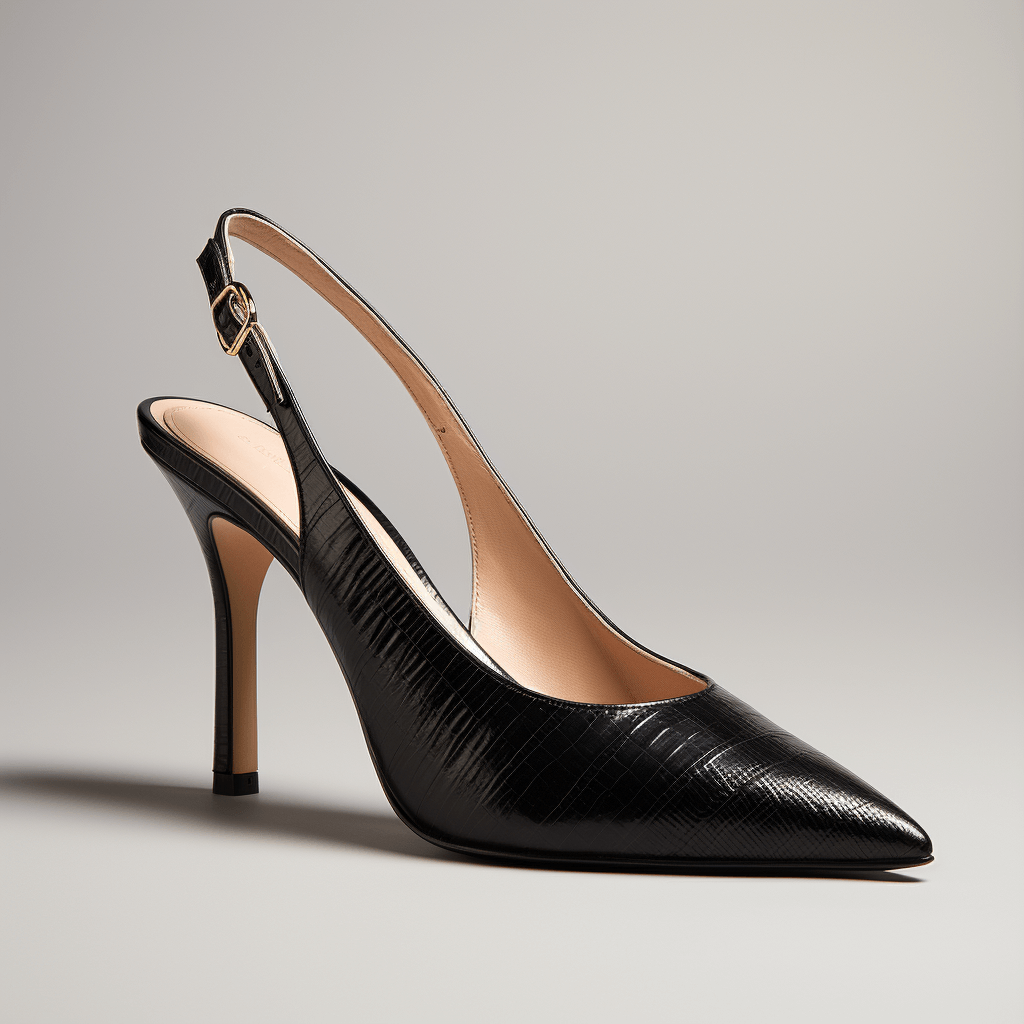
Slingbacks are defined by a strap that crosses behind the heel or ankle, rather than encircling the ankle. This design offers a secure fit while showcasing more of the foot, making it a versatile choice for both casual and formal occasions.
Historical Origin: The slingback heel emerged as a stylish solution in the 1930s, providing elegance with practicality. This style allowed women to have the allure of a heel without the confinement of a full shoe, particularly appealing during warmer seasons.
Distinctive Features: Slingbacks are distinguished by a strap that crosses behind the heel or ankle, rather than enclosing the foot completely. This open design lends an airy, feminine touch to the footwear.
Popular Wear Occasions: Given their breezy design, slingbacks are a favorite for spring and summer events, such as garden parties, weddings, or daytime outings.
Styling Tips: Pairing slingbacks with A-line dresses, pencil skirts, or cropped pants can accentuate the ankles and elongate the legs, creating a graceful silhouette.
Comfort Level: While offering the allure of heeled shoes, the open back design can sometimes cause the foot to slide forward. Choosing a well-fitted pair is crucial for optimum comfort.
Variations & Subtypes: While traditionally featuring a kitten or mid-heel, contemporary slingbacks can be found with block, stiletto, or even flat soles.
Celebrities & Icons: Audrey Hepburn, a symbol of timeless elegance, often wore slingbacks, bringing widespread attention to this style. Modern-day style icons like Meghan Markle have also been spotted in slingbacks, proving their enduring appeal.
Ankle Strap

These heels feature a strap that encircles the ankle, providing added support and stability. The design is both functional and fashionable, often adding a touch of elegance to the overall look.
Historical Origin: The allure of ankle strap heels is timeless, with traces of its style seen across various cultures and eras. From ancient Egyptian sandals to the Roaring Twenties, the ankle strap has been a consistent fashion statement.
Distinctive Features: Defined by a strap that encircles the ankle, these heels not only offer a secure fit but also add a decorative element to the shoe’s design.
Popular Wear Occasions: With their secure fit, ankle strap heels are versatile, making them suitable for dancing, formal events, and even everyday wear.
Styling Tips: Ankle strap heels are a perfect match for dresses, skirts, or shorts as they highlight the ankles. When paired with longer pants or jeans, they can provide a chic peek-a-boo effect.
Comfort Level: The additional strap provides extra support and stability, especially when navigating uneven surfaces or during prolonged wear. However, ensuring the strap isn’t too tight is essential to avoid discomfort.
Variations & Subtypes: While often associated with high heels, ankle straps are versatile and can be found on sandals, flats, and even platform shoes.
Celebrities & Icons: Icons like Marilyn Monroe and modern stars like Blake Lively and Emma Stone have been captivated by ankle strap heels, using them to make fashion-forward statements on and off the red carpet.
Mule
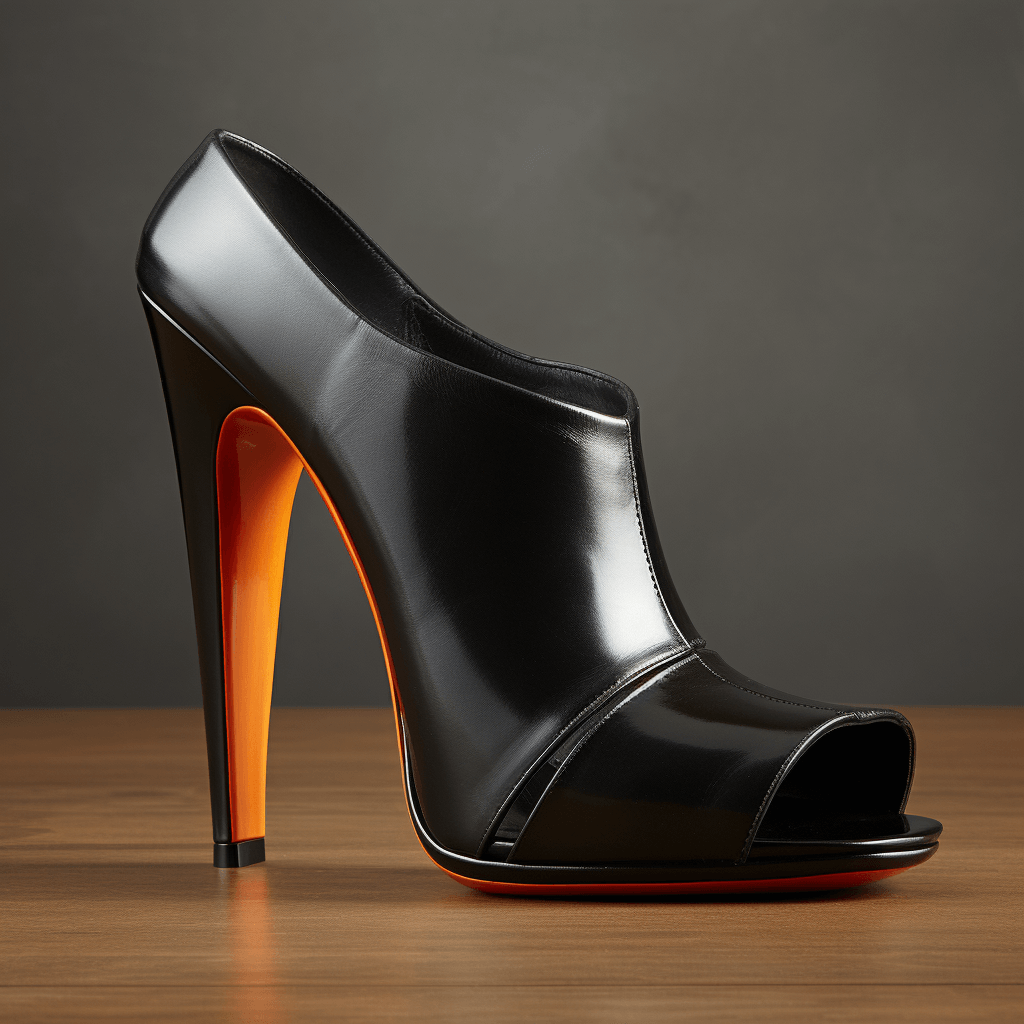
Mules are backless shoes often characterized by a closed toe. They can have any heel type, from flat to high. Their easy slip-on design makes them a favorite for many, offering a blend of convenience and style.
Historical Origin: The term “mule” in footwear dates back to Ancient Rome but gained popularity in Europe during the 16th century. Historically worn by both men and women, mules became a fashionable women’s shoe in the 1950s and saw a resurgence in the 1990s.
Distinctive Features: Mules are backless shoes, often with a closed toe. Their easy slip-on design combined with chic appeal makes them a versatile choice.
Popular Wear Occasions: Mules are great for a casual brunch, office wear, or a sophisticated evening out, thanks to their various designs and heel heights.
Styling Tips: Mules pair seamlessly with tailored trousers, midi skirts, or even denim, depending on the heel height and design. Their backless nature offers a breezy feel for warmer days.
Comfort Level: Generally, mules provide a good balance of style and comfort, especially when opted in a block heel or flat design. However, some might find the lack of back support a bit challenging during prolonged wear.
Variations & Subtypes: Mules come in various designs from flats to high heels, adorned with embellishments or presented in a minimalistic style.
Celebrities & Icons: Style icons like Sarah Jessica Parker and Victoria Beckham have frequently been seen sporting mules, establishing them as a must-have for every fashion enthusiast.
Peep Toe
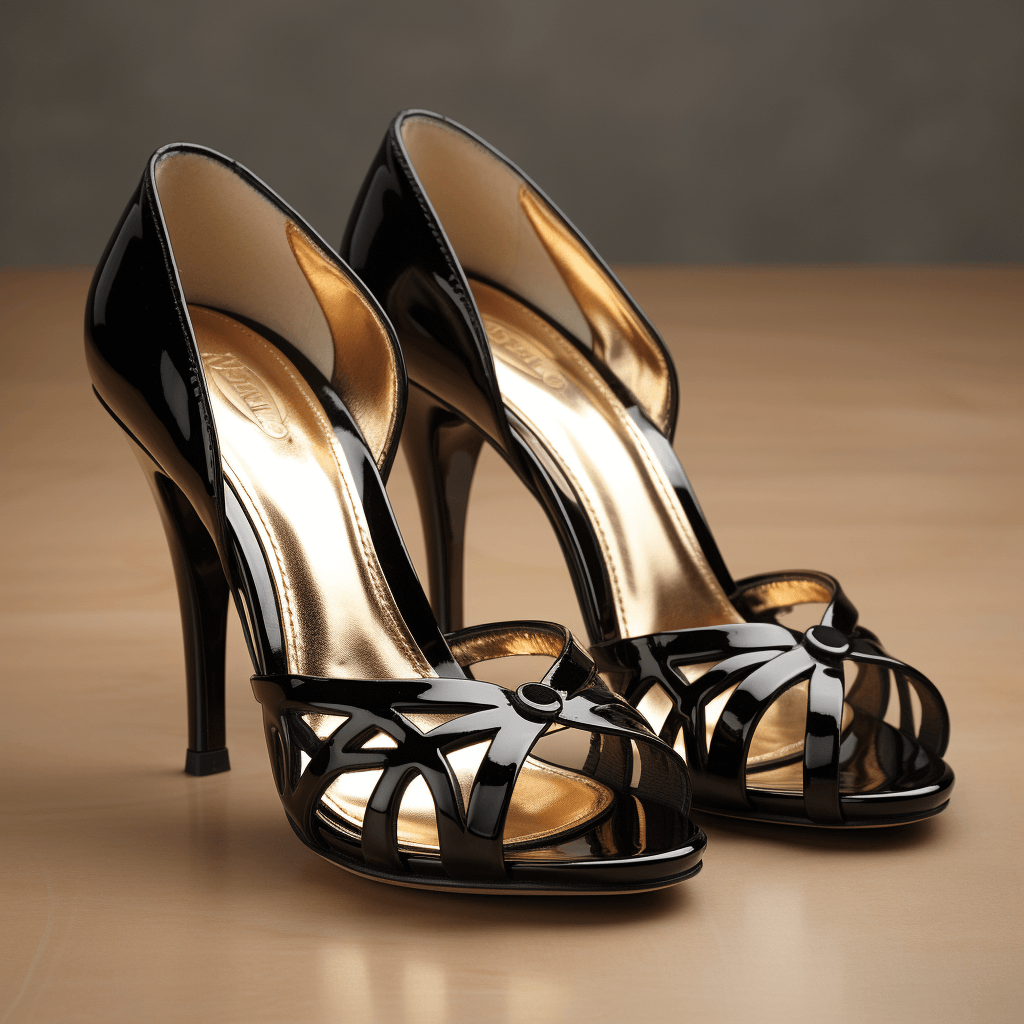
Peep toes, as the name implies, have a small opening at the tip, allowing the first one or two toes to “peep” out. They’re a fun choice that adds a flirty touch to outfits, perfect for warmer weather.
Historical Origin: Peep toes emerged in the fashion scene during the 1930s and soared in popularity throughout the 1940s. Offering a teasing glimpse of the toes, they provided a playful yet elegant alternative to the traditional closed-toe shoes.
Distinctive Features: As the name suggests, peep toe heels have a small opening at the toe box, allowing a few toes to “peep” out, giving them their distinctive appearance.
Popular Wear Occasions: From office settings to weddings and cocktail parties, peep toes offer versatility that suits various occasions.
Styling Tips: Pair peep toes with a polished pedicure for a refined look. They go well with dresses, skirts, and even tailored pants, allowing for a pop of nail color to shine through.
Comfort Level: Offering the elegance of heels while giving the toes some breathing space, peep toes are generally comfortable for extended periods, especially if chosen with a moderate heel height.
Variations & Subtypes: While commonly found in pumps, the peep toe design has made its way to boots, slingbacks, and even wedges.
Celebrities & Icons: Hollywood legends like Marilyn Monroe were often seen flaunting peep toe heels. Modern celebrities, including Reese Witherspoon and Kate Middleton, have also embraced the style, proving its enduring charm.
T-strap
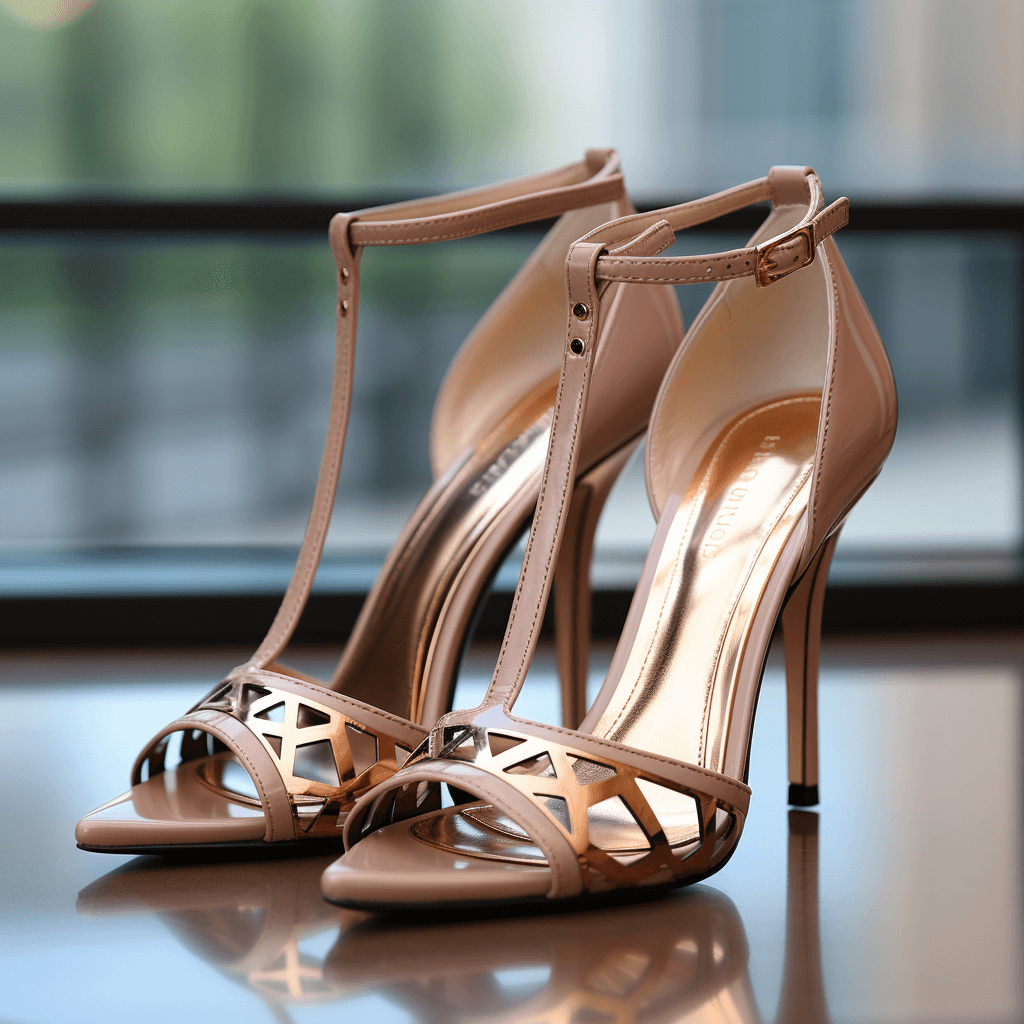
T-strap heels have a vertical strap running up the center of the foot and joining with a horizontal strap, forming a ‘T’ shape. This design ensures a secure fit while adding a vintage charm to the wearer’s ensemble.
Historical Origin: T-strap heels, also known as T-bar shoes, gained massive popularity in the 1920s and 1930s. Originally designed for dancing, they provided support and style, ensuring the shoe stayed in place during lively dance numbers.
Distinctive Features: The hallmark of the T-strap heel is the vertical strap that runs up the foot and joins a horizontal strap, creating a ‘T’ shape. This design offers added support and a snug fit.
Popular Wear Occasions: Today, T-straps are a favorite choice for vintage-themed events, dance parties, and weddings. Their classic design evokes a sense of nostalgia and elegance.
Styling Tips: Highlight the T-strap design by pairing with knee-length skirts or dresses. They also work beautifully with flapper dresses for a roaring twenties look.
Comfort Level: The additional strap provides enhanced support, making them more comfortable than some other heel types, especially for dancing or prolonged wear.
Variations & Subtypes: While traditionally associated with heels, T-strap designs are also found in flats and wedges, offering a variety of styles for different occasions.
Celebrities & Icons: Icons like Ginger Rogers elegantly danced in T-strap heels on the silver screen. Today, stars like Taylor Swift have been spotted embracing the vintage charm of the T-strap.
Mary Jane
Mary Janes are characterized by a strap over the top of the foot, often secured with a buckle. Originally designed for children, they’ve become a timeless choice for women, offering a sweet and classic look.
Historical Origin: Mary Janes trace their origins back to the early 20th century. They were initially designed for children but quickly became popular among women for their feminine and demure look. Their name is believed to have been derived from a character in the Buster Brown comic strip.
Distinctive Features: Mary Jane shoes are characterized by their broad and rounded toe and a strap across the instep. The strap often has a button or buckle closure.
Popular Wear Occasions: Mary Janes are versatile and can be worn in both casual and formal settings, including offices, dates, and even special ceremonies.
Styling Tips: These shoes add a touch of youthful innocence to any outfit. Pair them with A-line skirts or dresses for a classic look, or with tailored trousers for a modern twist.
Comfort Level: The foot-securing strap makes Mary Janes comfortable for extended wear. Opt for a lower heel or platform style for added comfort.
Variations & Subtypes: While traditionally low-heeled, Mary Janes now come in a variety of styles, including high heels, platforms, and even flats.
Celebrities & Icons: Legendary actress Shirley Temple popularized Mary Janes during her childhood years. Modern fashion-forward personalities like Alexa Chung and Zooey Deschanel often flaunt their love for this timeless style.
Pump
Pumps are often considered the most classic type of heel. They are usually closed-toe and have a low-cut front. The heel can vary in height, but regardless of size, pumps are a staple in many wardrobes due to their versatility and timeless appeal.
Historical Origin: Pumps, also known as court shoes, have been a staple in women’s fashion since the 18th century. Originating in Europe, they were once worn by both genders but eventually became predominantly women’s footwear by the 19th century.
Distinctive Features: A pump is typically a low-cut shoe, without a fastening, but with a heel. The classic pump has a seamless vamp and is made without laces, buckles, or straps.
Popular Wear Occasions: Pumps are versatile and can seamlessly transition from office wear to evening wear. They’re a go-to for business meetings, weddings, parties, and more.
Styling Tips: Pumps add polish to virtually any outfit. For office attire, pair them with a pencil skirt or tailored pants. For evenings, they complement cocktail dresses and gowns effortlessly.
Comfort Level: Depending on the heel height, pumps can range from being comfortable to slightly challenging for prolonged wear. Cushioned insoles or gel inserts can enhance comfort.
Variations & Subtypes: Pumps come in various designs, including pointed-toe, round-toe, and peep-toe. Heel heights can vary from kitten heels to stilettos.
Celebrities & Icons: Icons like Audrey Hepburn, Marilyn Monroe, and Princess Diana have all popularized different styles of pumps over the decades. In modern times, celebrities like Sarah Jessica Parker and Jennifer Aniston often sport chic pumps on the red carpet.
Ballet
Ballet heels take inspiration from ballet pointe shoes. They force the wearer’s feet into a pointe position, and while they’re more of a fashion statement than practical footwear, they offer a unique and dramatic look.
Historical Origin: Inspired by traditional ballet shoes, ballet heels or ballet pumps have their roots in the world of dance. The flat version has been worn outside of dance since the 16th century, while the heeled version is a more modern innovation, often seen in high-fashion contexts.
Distinctive Features: Ballet heels elevate the design of the traditional ballet slipper, with an extremely high heel that forces the foot into an en pointe (pointed) position.
Popular Wear Occasions: Ballet flats are daily wear staples, perfect for casual outings or office settings. Ballet heels, on the other hand, are more for fashion enthusiasts and are not recommended for prolonged wear due to their extreme design.
Styling Tips: Ballet flats pair well with skinny jeans, sundresses, and skirts. For the adventurous wanting to try ballet heels, they’re best worn as statement pieces with minimalist outfits, drawing attention to the shoes.
Comfort Level: Ballet flats are known for comfort and can be worn all day. Ballet heels, however, are considered one of the least comfortable shoes due to the extreme arch.
Variations & Subtypes: Ballet flats come in a variety of materials, from leather to canvas, and can feature embellishments like bows or jewels. Ballet heels are mostly seen in fetish fashion and avant-garde runway shows.
Celebrities & Icons: Audrey Hepburn’s portrayal in “Funny Face” and her personal style made ballet flats iconic. Ballet heels, being more niche, have been seen on celebrities like Lady Gaga, pushing fashion boundaries.
High Heel Sandal
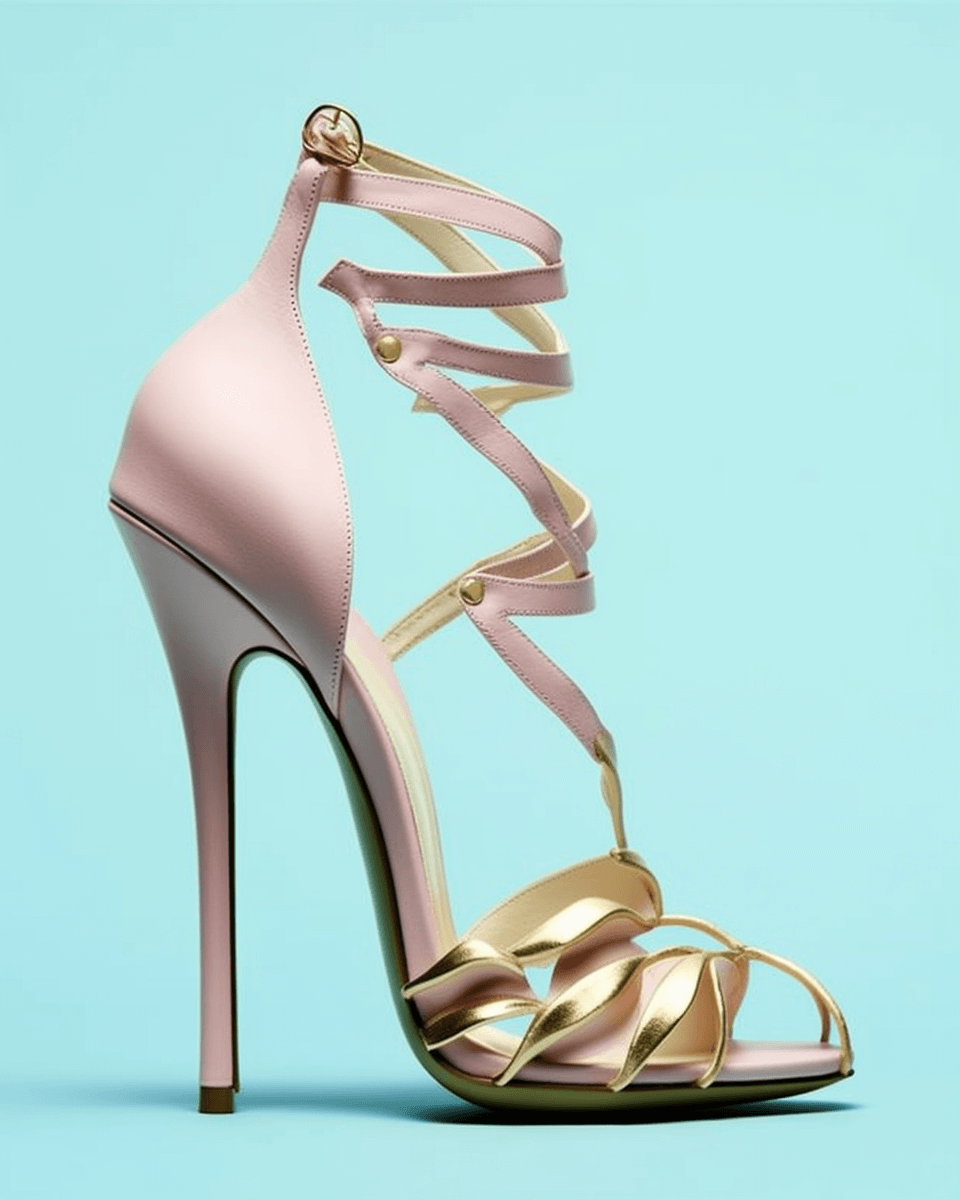
These are open-toed sandals elevated with any style of heel. They’re versatile and can range from casual designs for beach outings to more sophisticated versions for evening wear.
Historical Origin: The concept of sandals dates back to ancient civilizations like the Egyptians, Greeks, and Romans. While these ancient sandals were flat, the introduction of a heel to the sandal design is more recent, emerging prominently in the 20th century as fashion began to prioritize aesthetics alongside functionality.
Distinctive Features: High heel sandals are characterized by an open design with straps that cross over the foot and/or wrap around the ankle. The heel elevates the wearer’s height and adds elegance to the otherwise casual sandal design.
Popular Wear Occasions: Ideal for spring and summer events, high heel sandals are popular choices for beach weddings, garden parties, and evening outings.
Styling Tips: These sandals pair beautifully with flowy dresses, skirts, and cropped trousers. When wearing with dresses, ensure the hem doesn’t drag on the ground.
Comfort Level: Varies based on design. A well-fitted high heel sandal with cushioning can be relatively comfortable. However, too-high heels or ill-fitted straps can cause discomfort.
Variations & Subtypes: Gladiator sandals, T-strap sandals, and ankle-strap sandals are all popular variations. Heel styles can vary from stilettos to block heels.
Celebrities & Icons: Celebrities like Rihanna, Zendaya, and Selena Gomez have been spotted flaunting high heel sandals at red carpet events, adding a touch of summer flair to their glamorous looks.
Cork High Heel
These heels are made with a sole or heel constructed from cork material. They’re lightweight and have a natural, earthy appearance, making them popular for summer outfits.
Historical Origin: The cork heel came into fashion prominence in the 1970s, influenced by the decade’s love for earthy and natural materials. Salvador Ferragamo is often credited with pioneering the use of cork (primarily due to wartime rationing of materials) for shoe design in the 1940s.
Distinctive Features: As the name suggests, the defining feature of a cork high heel is its heel made from cork material. The contrast of cork against other shoe materials offers a unique aesthetic appeal.
Popular Wear Occasions: Cork high heels, particularly wedges, are popular in spring and summer. They are commonly seen at casual brunches, beach parties, and summer festivals.
Styling Tips: These heels work wonderfully with summer dresses, shorts, and skirts. They provide a boho-chic vibe, making them great for casual, laid-back looks.
Comfort Level: Cork heels, especially when used in wedge designs, offer better stability and comfort than stilettos, making them suitable for longer wear times.
Variations & Subtypes: While the classic cork heel is a wedge, designers have incorporated cork into various heel designs, including block and platform heels.
Celebrities & Icons: Icons of the ’70s like Jane Birkin and Brigitte Bardot have sported cork heels, establishing their chic yet casual reputation. Modern-day celebrities like Kate Middleton have also embraced the cork heel trend, especially during summer months.
Oxfords
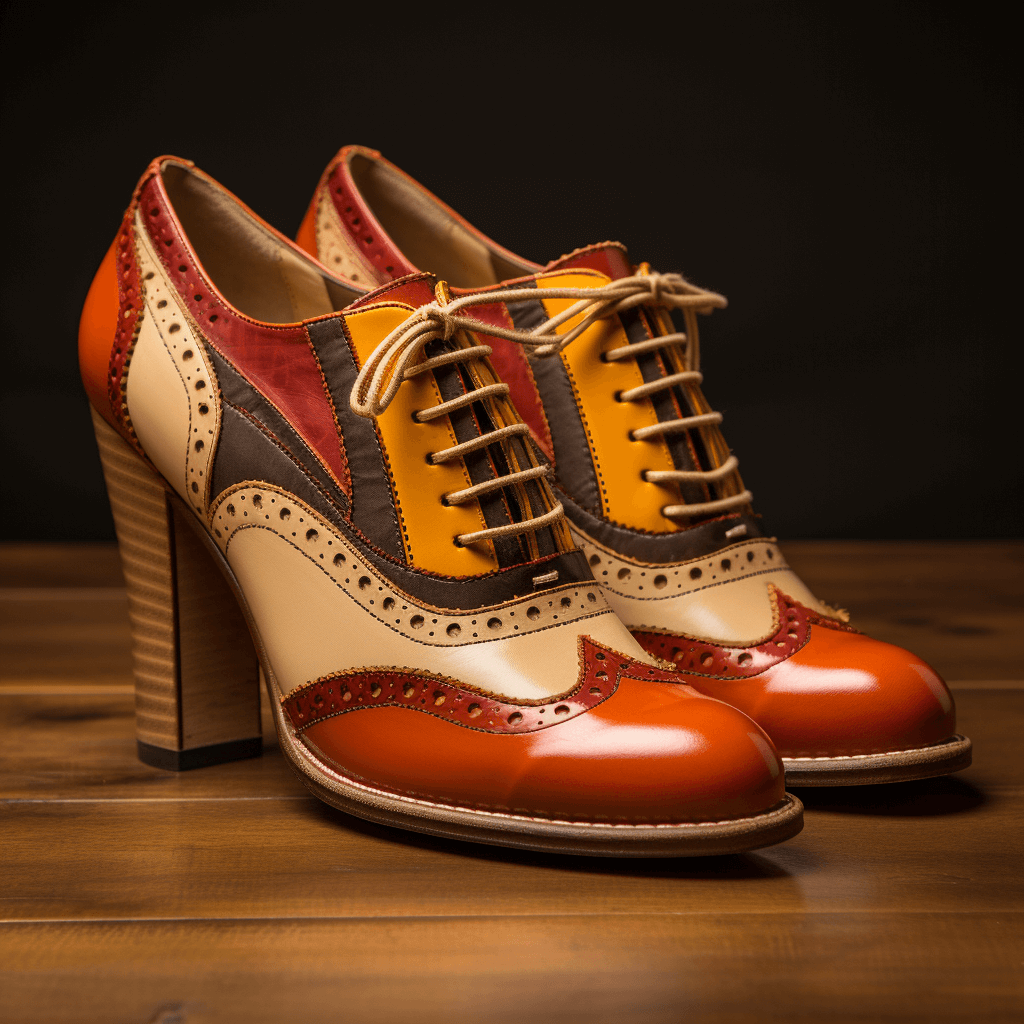
Oxfords are traditionally low-heeled shoes characterized by a lace-up front. While they originated as men’s footwear, women’s versions often come with a heel, blending classic design with feminine style.
Historical Origin: Named after Oxford University, these shoes have a long-standing history dating back to the 1800s. Originally men’s shoes, Oxfords made their transition to women’s fashion in the 20th century, when heel heights started varying from flat to high, merging classic style with modern elegance.
Distinctive Features: Recognized by their closed lacing system, Oxfords have a low heel and are typically made of leather. The sleek design is accented by a cap toe and occasionally brogue detailing.
Popular Wear Occasions: Oxfords are versatile. While historically a formal shoe, they’re now worn in both formal settings like offices and casual outings alike, thanks to contemporary design adaptations.
Styling Tips: Pair Oxfords with tailored trousers or a pencil skirt for a professional look. For a more casual vibe, wear them with cuffed jeans and a blazer.
Comfort Level: Generally high. The flat or low-heeled design and secure lacing system ensure a snug fit, providing all-day comfort.
Variations & Subtypes: Beyond the classic leather design, modern Oxfords come in a variety of materials, including suede and patent leather. Brogues, with their decorative perforations, are a subtype of Oxfords.
Celebrities & Icons: Emma Watson, Taylor Swift, and Alexa Chung have all embraced the Oxford style, showcasing its adaptability from red carpets to street style.
Cut-out
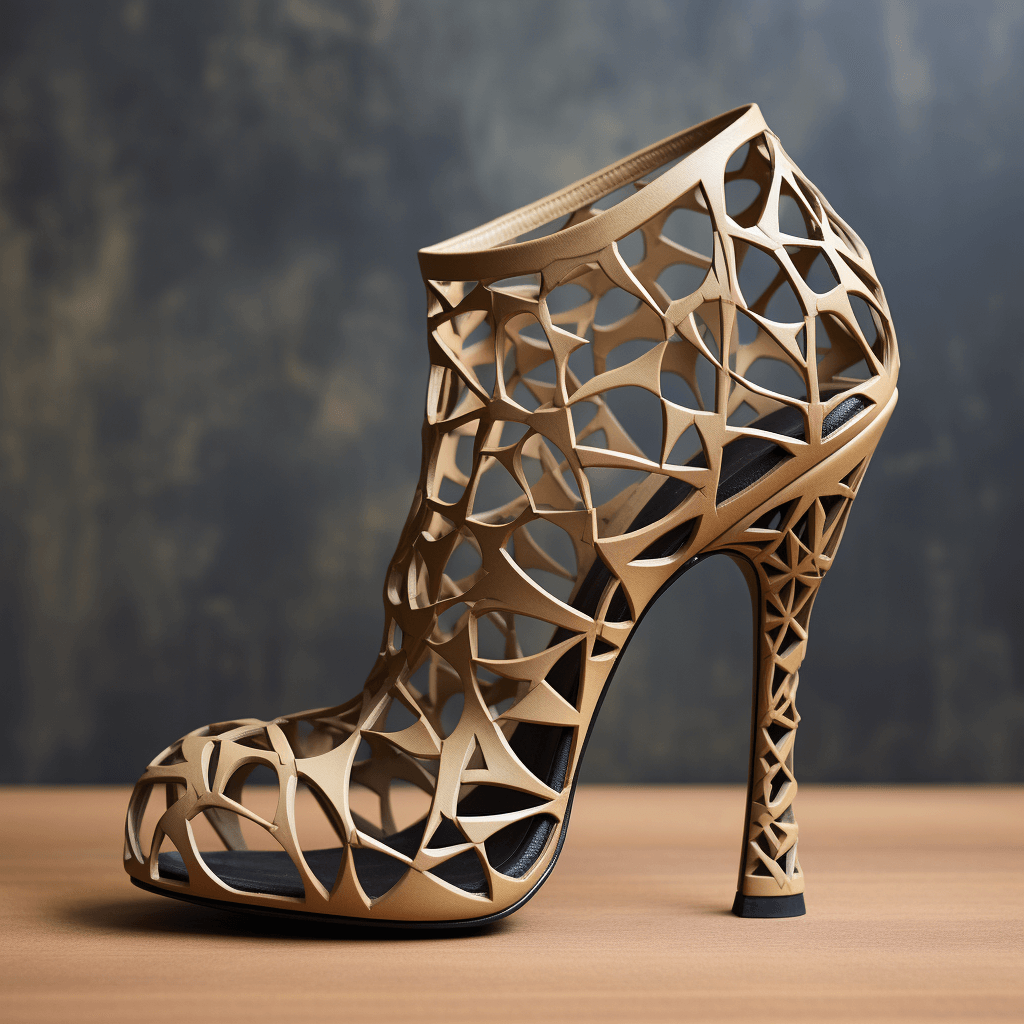
Cut-out heels feature designs where portions of the shoe are cut out, creating patterns or designs. They offer a unique and edgy look, perfect for making a fashion statement.
Historical Origin: The cut-out heel trend is relatively modern, emerging prominently in the late 20th and early 21st centuries as designers began experimenting with shoe structures, prioritizing aesthetic intrigue alongside functionality.
Distinctive Features: As the name suggests, cut-out heels feature strategic gaps or “cut-outs” in the design, either on the sides, back, or even the heel itself. This creates an avant-garde, edgy appearance.
Popular Wear Occasions: These are versatile shoes, suitable for both day and night. The striking design is perfect for fashion-forward events, parties, or even a bold office look.
Styling Tips: Given their statement nature, cut-out heels pair well with minimalist outfits, letting the shoes grab attention. Think solid color dresses or monochrome outfits.
Comfort Level: Varies depending on the design. Some cut-out designs can offer more ventilation, making them more comfortable in warmer weather. However, the structural integrity is crucial for comfort, so it’s essential to choose a well-designed pair.
Variations & Subtypes: From subtle side gaps to intricate patterns that look like artwork, the cut-out design varies widely. Some even incorporate laces or straps into the cut-out design for added flair.
Celebrities & Icons: Stars like Gigi Hadid, Rihanna, and Selena Gomez have been spotted in cut-out heels, showcasing their edgy appeal and fashion-forward nature.
Gladiator
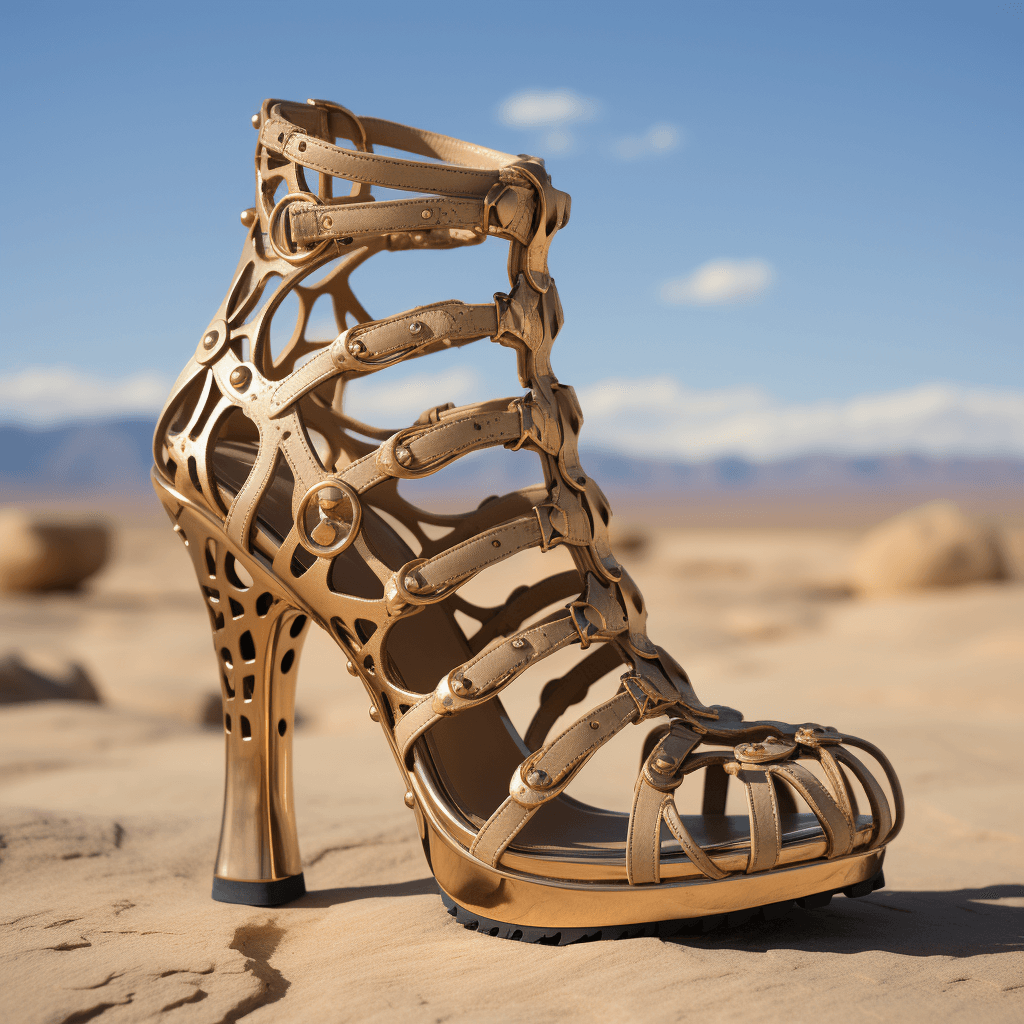
Inspired by ancient Roman footwear, gladiator heels are characterized by multiple straps that wrap around the foot and often the calf. They offer a bold and edgy look, perfect for making a statement.
Historical Origin: Drawing inspiration from ancient Rome, gladiator sandals have roots that date back thousands of years. Roman gladiators wore them in arenas. This classic design has been reinterpreted over time, with heels adding a modern twist to the age-old style.
Distinctive Features: Gladiator heels are characterized by their multiple straps that run across the foot and often up the ankle or calf. They might be laced, buckled, or zipped, and can range from short ankle-length versions to dramatic knee-high styles.
Popular Wear Occasions: These are a summer favorite, ideal for festivals, beach parties, or casual outings. They add an edgy touch to any outfit and are a surefire statement piece.
Styling Tips: Gladiator heels look stunning with short dresses, skirts, or shorts, allowing the straps to be the focal point. For a boho chic vibe, pair them with a flowy maxi dress.
Comfort Level: It varies. While the multiple straps offer good support, it’s crucial to ensure a proper fit to avoid any discomfort or chafing.
Variations & Subtypes: Modern gladiators come in various materials and colors. Some have intricate woven patterns, while others may incorporate metallic studs or embellishments for added flair.
Celebrities & Icons: Stars such as Kendall Jenner, Rita Ora, and Diane Kruger have elegantly sported gladiator heels, giving them a contemporary and fashionable spin.
D’Orsay
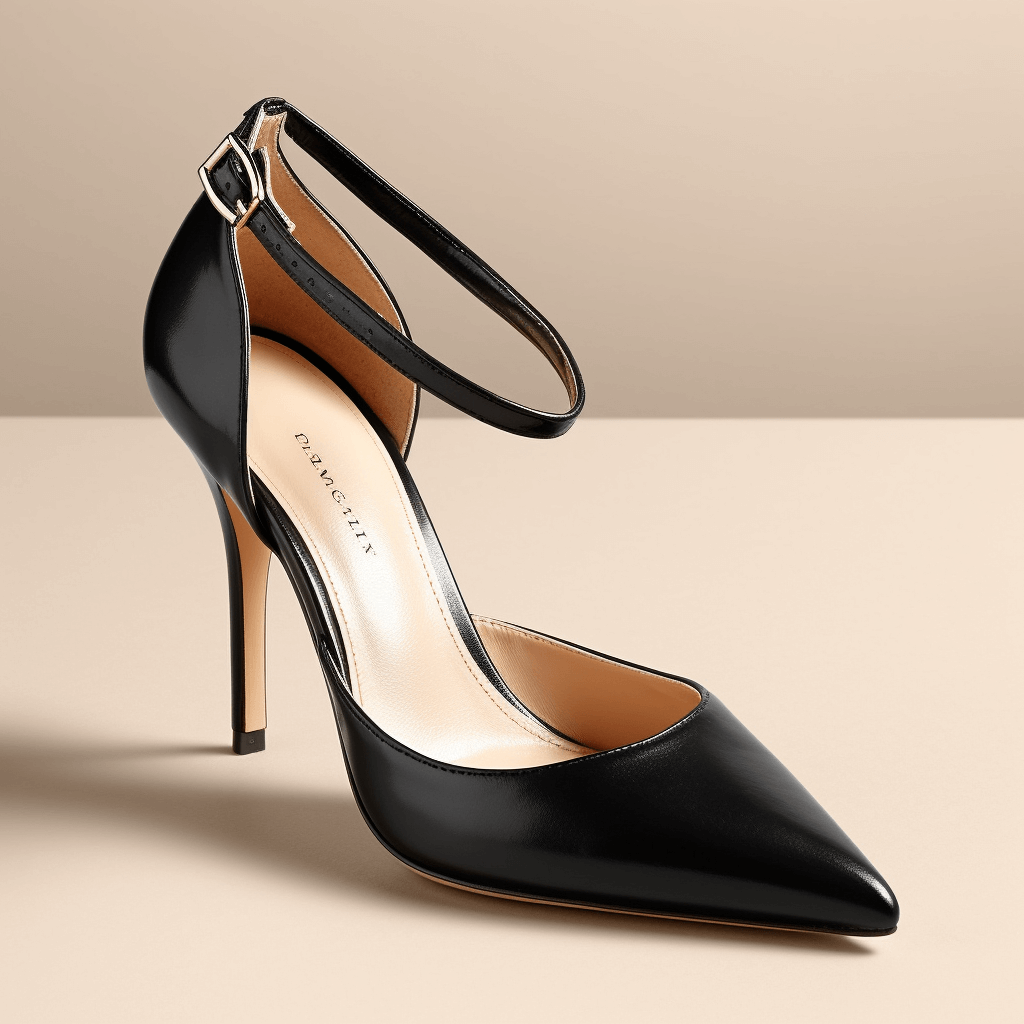
The D’Orsay style features a cut-out side, exposing the arch of the foot. It’s a sophisticated design that can be found in both flats and heels, offering a blend of elegance and allure.
Historical Origin: Named after Count Alfred d’Orsay, a 19th-century French artist and dandy, the d’Orsay style has an aristocratic flair. Originally designed for men, it soon became a ladies’ favorite, signifying elegance and sophistication.
Distinctive Features: The d’Orsay heel is defined by its side cut-outs, which expose the arch of the foot, while the front and back of the shoe remain intact. This design creates a sleek and flattering silhouette.
Popular Wear Occasions: Due to their refined appearance, d’Orsay heels are perfect for formal events, weddings, and sophisticated soirées. They exude timeless elegance and are a staple in many women’s wardrobes.
Styling Tips: These heels are incredibly versatile and can be paired with everything from elegant evening gowns to tailored pantsuits. Their ability to elongate the leg makes them a popular choice with shorter dresses and skirts.
Comfort Level: Generally, they offer a medium comfort level. The open sides provide ventilation, but some might find the arch exposure less supportive. It’s essential to choose a well-fitted pair to prevent slipping.
Variations & Subtypes: While traditionally d’Orsay heels come in a classic design, modern interpretations might include pointed toes, ankle straps, or varied heel heights.
Celebrities & Icons: Iconic figures like Audrey Hepburn and contemporary stars like Emma Stone have beautifully adorned d’Orsay heels, testifying to their timeless appeal.
Ballroom
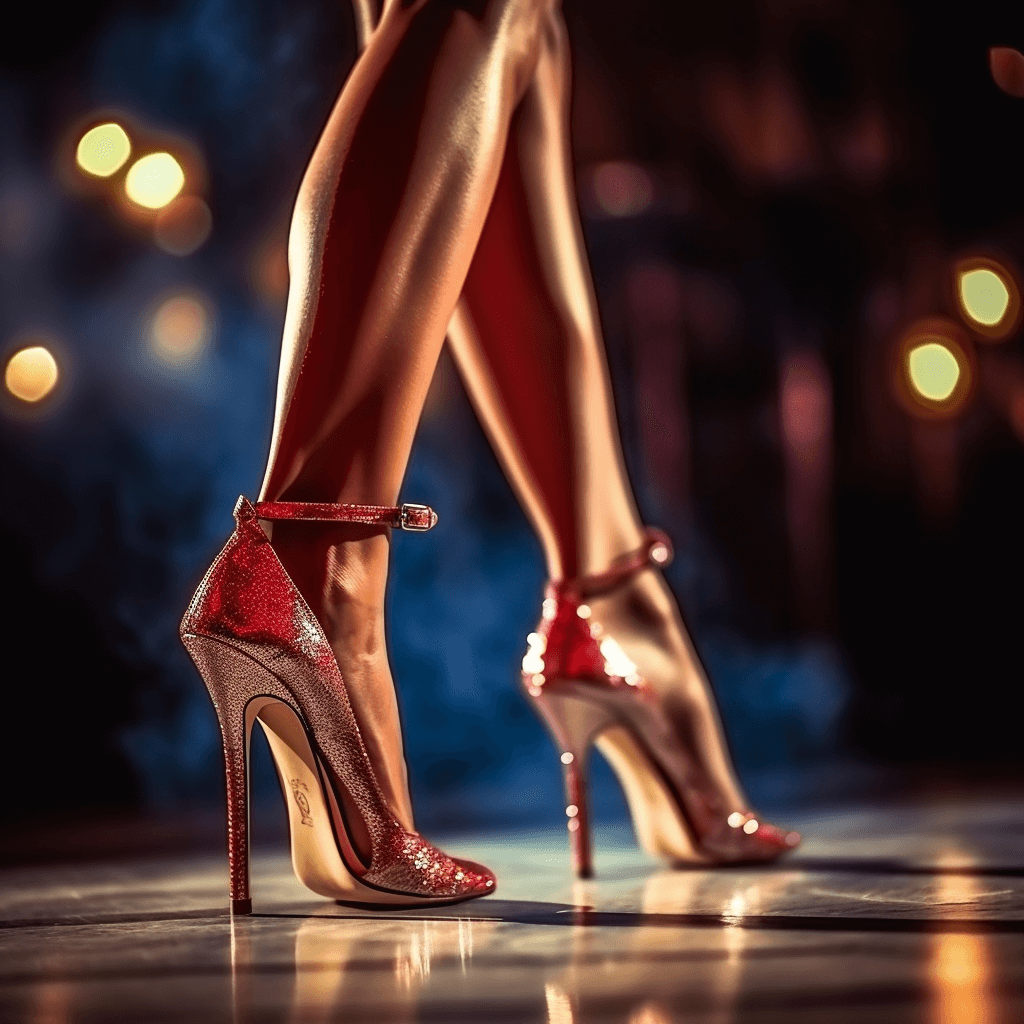
Ballroom heels are designed specifically for ballroom dancing. They offer stability and flexibility, with a secured strap to ensure the shoe stays in place during dance routines.
Historical Origin: As the name suggests, Ballroom heels hail from the grand ballrooms of yesteryears, designed specifically for ballroom dancing. They’ve been an integral part of dance culture since the early 20th century, providing elegance and functionality.
Distinctive Features: Ballroom heels are engineered for dance. They come with a secured fit, often with a T-strap for added support. The heel’s placement is closer to the shoe’s middle, ensuring better weight distribution, and they often feature suede soles for optimal floor grip.
Popular Wear Occasions: While primarily designed for dancing, many women don these heels for formal events due to their classic and graceful design.
Styling Tips: Best paired with flowing dresses that accentuate movement. For non-dance occasions, they can elegantly complement midi dresses or tailored pants.
Comfort Level: Given their design for dance, they are surprisingly comfortable with adequate foot support. However, like all heels, prolonged wear might lead to discomfort.
Variations & Subtypes: While the classic ballroom shoe is closed-toe, variations include the Latin style, which is open-toed and designed for dances like the cha-cha or rumba.
Celebrities & Icons: Dance legends like Ginger Rogers have graced dance floors in ballroom heels, and contemporary dance pros like Julianne Hough have kept the tradition alive on platforms like “Dancing with the Stars”.
Cuban
The Cuban heel is a medium-height, straight-sided heel. It’s often found on men’s boots and women’s vintage-style shoes, offering a sturdy and classic look.
Historical Origin: The Cuban heel, with its origins in Latin America, especially in Cuban dance culture, has been popular since the 20th century. It was initially designed for men’s dance shoes but eventually gained traction in women’s fashion.
Distinctive Features: Recognized by its sturdy and blocky appearance, the Cuban heel is shorter and wider at the base, tapering slightly inwards. It provides height without compromising too much on comfort.
Popular Wear Occasions: Cuban heels are versatile. They’re seen in both formal settings, like dance events, and more casual ones, like outings or casual Fridays at the office.
Styling Tips: For women, Cuban heels go wonderfully with pencil skirts or slim trousers, giving a vintage flair. When paired with jeans or A-line dresses, they offer a more relaxed yet polished look.
Comfort Level: One of the more comfortable heel styles due to its broader base. It offers stability, making it suitable for prolonged wear.
Variations & Subtypes: Cuban heels are often associated with certain types of boots, like cowboy boots. They can also be found in more formal lace-up styles.
Celebrities & Icons: Icons like Mary Quant in the ’60s rocked the Cuban heel, while modern celebrities like Alexa Chung have reincorporated them into contemporary fashion.
Prism
Prism heels have a triangular shape, with three flat sides that converge to a point at the base. They offer a modern and geometric aesthetic to footwear.
Historical Origin: The Prism heel is a relatively modern innovation in the world of fashion footwear, emerging as designers started to experiment with sculptural and geometric heel designs in the late 20th and early 21st centuries.
Distinctive Features: As the name suggests, Prism heels take inspiration from the three-dimensional triangular shape. These heels often look like an inverted pyramid and can sometimes be transparent or made of colorful materials, reflecting light in captivating ways.
Popular Wear Occasions: Due to their modern and striking appearance, Prism heels are a popular choice for fashion-forward events, red carpets, and parties where making a statement is essential.
Styling Tips: To let the heel shine, pair it with minimalist outfits. A sleek black dress or tailored jumpsuit can be a perfect backdrop for these artful shoes.
Comfort Level: The broad base offers stability, but as with many high-fashion designs, extended wear might not be the most comfortable.
Variations & Subtypes: Some Prism heels are entirely transparent, while others use a mix of materials or include internal lights for an added wow factor.
Celebrities & Icons: Fashion-forward celebrities like Lady Gaga and Rihanna have been seen flaunting Prism heels, making them a favorite for those who love to stand out.
Fantasy
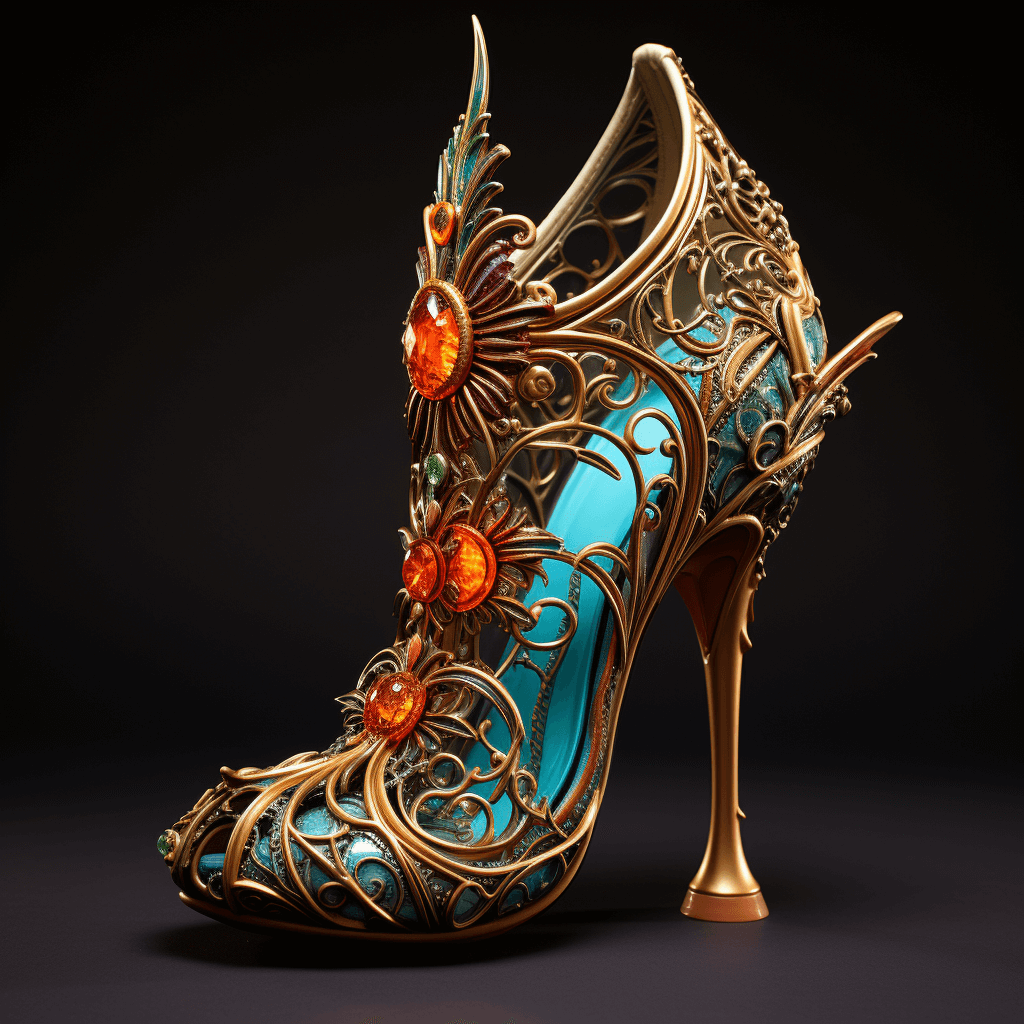
As the name suggests, fantasy heels are all about imagination and creativity. They come in various unique designs, often inspired by themes, characters, or abstract concepts, making them standout pieces.
Historical Origin: The Fantasy heel does not trace back to a specific period but is more a culmination of designers letting their imagination run wild. Over the past few decades, as high fashion became more experimental, these whimsical heels took center stage.
Distinctive Features: Almost anything goes with Fantasy heels! They’re characterized by their unique, often avant-garde designs which can include everything from animal shapes to city skylines, or even heels that seemingly disappear, giving the illusion of floating.
Popular Wear Occasions: These are the heels you wear when you want all eyes on you—red carpets, avant-garde fashion shows, or themed parties.
Styling Tips: Since Fantasy heels are a statement in themselves, it’s best to keep the rest of the outfit understated. A simple, monochromatic ensemble can make these heels pop even more.
Comfort Level: As these heels prioritize style over comfort, they might not be the best for long durations. However, some designs might surprise you with their wearability.
Variations & Subtypes: The sky’s the limit! From heels with intricate lacework to those with embedded LEDs, the Fantasy category is ever-evolving.
Celebrities & Icons: Stars like Björk and Katy Perry, known for their eccentric style, often embrace Fantasy heels, showcasing the wilder side of fashion.
Flared
Flared heels widen at the base, providing more surface area and stability. The design adds a touch of retro flair to the shoe.
Historical Origin: The Flared heel made its debut in the 1970s, alongside the rise of disco culture. Its design, reminiscent of the bell-bottom trend, made it a hit during this vibrant era.
Distinctive Features: Flared heels have a broader base than the top, creating an outward curve. This design gives an added stability compared to traditional stilettos, without compromising on height or style.
Popular Wear Occasions: These heels are versatile. While they initially boomed in nightclubs and discotheques, today they can be worn for formal events, dinners, and even in professional settings, depending on the overall design of the shoe.
Styling Tips: To give a nod to their retro origins, pair Flared heels with wide-leg trousers or a midi skirt. For a more modern look, they work beautifully with pencil skirts or tailored dresses.
Comfort Level: Thanks to their wider base, Flared heels provide better balance and are generally more comfortable than stilettos, making them suitable for extended wear.
Variations & Subtypes: While the classic Flared heel retains its 70s design, modern interpretations have incorporated transparent materials, metallic finishes, and even decorative embellishments.
Celebrities & Icons: Icons of the 70s like Donna Summer were fans of the Flared heel. Today, fashion-forward celebrities like Zendaya and Gigi Hadid have been spotted reviving the trend.
French
Also known as the Louis XV heel, the French heel has a curve and is shorter and thicker than a stiletto. It’s a classic design that adds a touch of vintage elegance.
Historical Origin: The French heel, also known as the Louis heel or Pompadour heel, traces its roots back to the 17th century. It was named after King Louis XIV of France, who, according to some tales, wore these heels to appear taller.
Distinctive Features: The French heel is characterized by its curved shape, which starts wide at the sole and narrows down to a smaller base. It’s a moderate heel, usually not exceeding three inches.
Popular Wear Occasions: Given its vintage appeal, the French heel is often associated with period costumes and classical events. However, they’re also making a comeback in high fashion circles and can be worn for semi-formal events, dates, or even work.
Styling Tips: These heels ooze vintage charm, making them perfect for A-line dresses, lace outfits, or anything with a romantic, old-world feel.
Comfort Level: Since they aren’t exceedingly high and have a curvaceous, supportive design, French heels are relatively comfortable for prolonged wear.
Variations & Subtypes: Modern takes on the French heel include versions with studs, prints, and even glitter. They may also vary in height, with some contemporary designs pushing the boundaries of the traditional height.
Celebrities & Icons: Keira Knightley, in her period films, and Taylor Swift, with her vintage-inspired style, have both showcased the timeless beauty of French heels.
Comma
True to its name, the comma heel resembles the punctuation mark, with a unique curved shape. It’s a contemporary design that adds a whimsical touch to footwear.
Historical Origin: The Comma heel is a relatively modern innovation, having made its appearance in the late 20th century. Its name and design are inspired by the punctuation mark, giving it a distinctive and avant-garde touch.
Distinctive Features: As the name suggests, the Comma heel has a curved shape similar to its namesake. It’s a visually striking design, blending the aesthetics of sculpture with footwear.
Popular Wear Occasions: Given its contemporary and bold design, the Comma heel is perfect for fashion-forward events, art galas, or any occasion where making a style statement is key.
Styling Tips: To let these unique heels shine, pair them with minimalist outfits like monochrome dresses or tailored pantsuits. The heel itself should be the focal point of your ensemble.
Comfort Level: Due to their curved design, Comma heels might require some getting used to. They offer moderate comfort and are best reserved for events where extensive walking is not required.
Variations & Subtypes: While the traditional Comma heel is a true homage to the punctuation, contemporary designs play with materials, incorporating metallics, transparent sections, or even LEDs for a futuristic touch.
Celebrities & Icons: Trendsetters like Lady Gaga and Rihanna have been seen rocking the Comma heel, showcasing its edgy appeal.
Blade
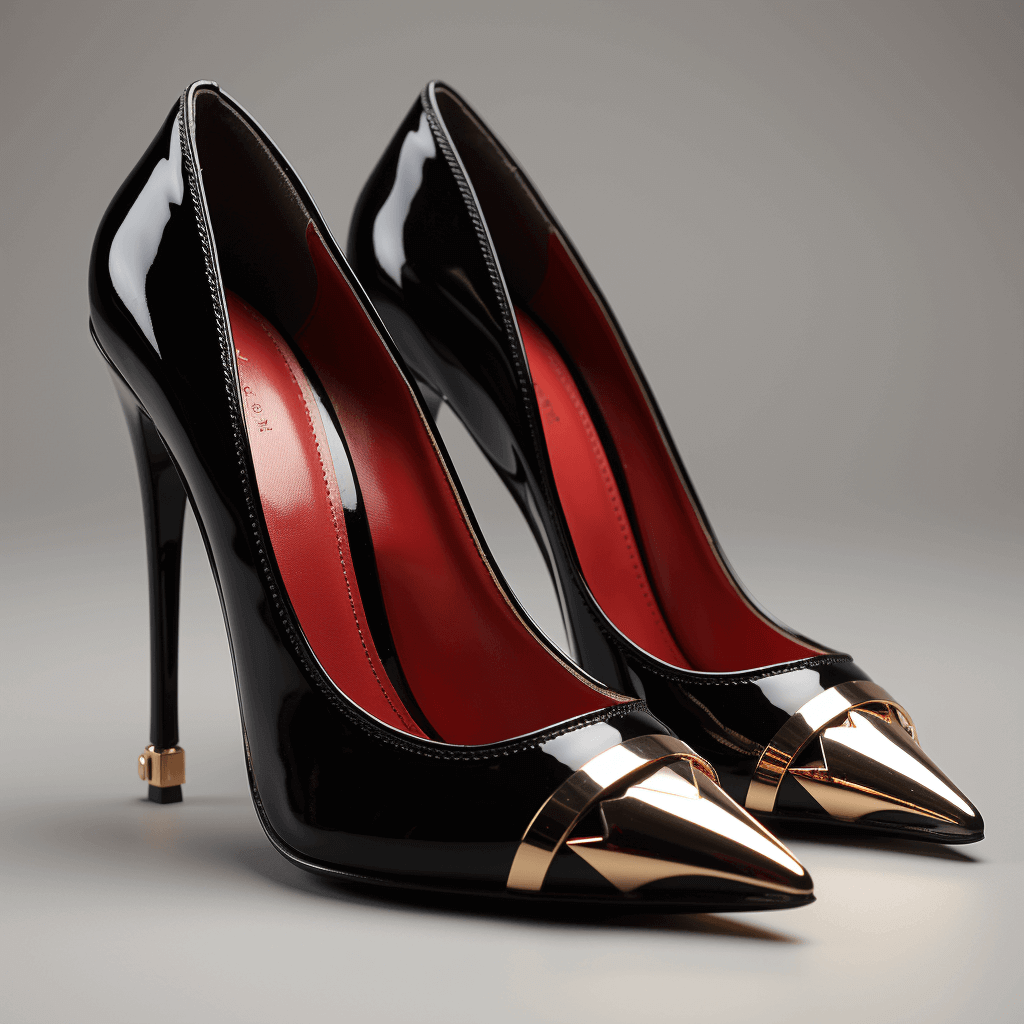
Blade heels have a thin and flat design, resembling the edge of a blade. They offer a sleek and modern look, perfect for fashion-forward individuals.
Historical Origin: The Blade heel is a modern invention, debuting in the 21st century and popularized by luxury designers who sought to push the boundaries of traditional heel design.
Distinctive Features: As the name implies, the Blade heel is razor-thin and sharp, resembling the edge of a blade. It’s sleek, metallic in many instances, and incredibly edgy.
Popular Wear Occasions: These heels scream sophistication and are ideal for high-profile events, red carpets, and upscale parties. Their design ensures they stand out, making them the perfect choice when looking to make a lasting impression.
Styling Tips: Blade heels complement elegant evening gowns and sleek cocktail dresses. Given their sharp look, it’s best to pair them with outfits that have clean lines and modern cuts.
Comfort Level: Their thin design might pose a challenge in terms of stability, so they’re more about style than comfort. It’s advisable to wear them for short durations or events where you won’t be on your feet for extended periods.
Variations & Subtypes: While silver and gold are the most common colors for Blade heels due to their metallic sheen, designers have begun introducing colored versions, studded designs, and even translucent variants.
Celebrities & Icons: A-listers like Victoria Beckham and Bella Hadid have confidently strutted in Blade heels, solidifying their status as high-fashion staples.
Choosing the Right Heel for Every Occasion
With an abundance of heel styles available, picking the perfect pair for an event can be a delightful yet daunting task. Whether you’re dressing for a casual day out, a business meeting, or an extravagant gala, the right heels can elevate your look and confidence. Let’s explore how to make that impeccable choice for every occasion.
Casual Day Out: Comfort Meets Style
- Wedges: A great blend of style and comfort, wedges offer the height without the pain. Their broader base provides support, making them perfect for a day of shopping or brunch.
- Block Heels: Offering stability and a chic look, block heels can be paired with jeans, dresses, or skirts for a casual yet stylish appearance.
- Esparadrilles: Perfect for summer outings, these heels give off a beachy vibe and go well with sundresses and shorts.
Work and Business Meetings: Professional and Poised
- Kitten Heels: Subtle yet sophisticated, kitten heels give a slight lift without being too imposing, making them ideal for a professional setting.
- Block Heels: Their stability and chic design make block heels a favorite for long workdays. Pair them with trousers or pencil skirts for a polished look.
- Oxfords: A nod to classic menswear, heeled oxfords are both formal and fashionable. They complement pantsuits and tailored dresses seamlessly.
Evening Gala and Parties: Dazzle the Night Away
For those glamorous nights where making a statement is essential, consider these heel types:
| Heel Type | Description |
|---|---|
| Stiletto: | The ultimate heel for elegance and height. Though they might challenge your balance, their beauty is undeniable. Best paired with evening gowns and cocktail dresses. |
| Platform: | Want the height without the pain? Platforms offer elevation with added comfort. They’re versatile and can be worn with both dresses and pants. |
| Ankle Strap: | Flattering and fashionable, ankle strap heels offer security and style. They beautifully accentuate the ankles and are a favorite for dance events. |
While the world of heels offers endless options, the key lies in matching the heel’s style, comfort level, and height to the occasion and your outfit. Remember, the best heels not only enhance your appearance but also boost your confidence. So, put your best foot forward and strut with grace!
Comfort in Elevation: Tips for Wearing High Heels Without Pain
We’ve all heard the saying, “Beauty is pain,” but when it comes to high heels, it doesn’t have to be. While heels elevate our style, they shouldn’t bring discomfort or health problems. Dive into this guide to ensure every step you take in heels is graceful and pain-free.
1. Right Fit is Paramount
Before anything else, ensure your heels fit perfectly. Too tight can cause bunions, while too loose may lead to blisters. When shopping, it’s best to try on heels in the afternoon or evening when your feet are at their largest due to natural swelling.
2. Gradual Increase in Heel Height
If you’re new to wearing heels, start low. Begin with a kitten heel or block heel and gradually work your way up as your comfort and confidence increase.
3. Platforms for the Win!
Platform heels offer the height of stilettos but with lesser strain on the arch, making them more comfortable. The platform absorbs some of the pressure, reducing foot fatigue.
4. Insoles and Cushioning
- Invest in Quality Insoles: Gel insoles or cushioned pads can be a lifesaver. They provide added comfort and reduce the impact on your soles.
- Padding for Ball of Foot: Some heels can put excessive pressure on the ball of the foot. Using metatarsal pads can help distribute pressure more evenly.
5. Stretch and Strengthen
Regular foot exercises and stretches can enhance foot strength and flexibility, making it easier to wear heels. Simple exercises like toe tappers or calf raises can make a world of difference.
6. Limit Wearing Time
If possible, don’t wear high heels for prolonged periods. It’s a good idea to alternate between heels and flat shoes during the day. Keeping a pair of ballet flats in your bag can be a game-changer for giving your feet a short break.
7. Proper Posture and Walking Technique
- Posture: Stand straight, engage your core, and keep your head elevated. Proper posture reduces strain on your back and feet.
- Walking Technique: Instead of placing your full foot down at once, walk heel to toe. This technique provides better balance and reduces pressure on the foot.
8. Heel Alternation
Continuously wearing the same pair of heels can strain specific foot muscles. By rotating between different heel types and heights, you’re ensuring that no single part of your foot is overburdened.
In the realm of fashion, while heels are a statement of elegance and stature, comfort remains paramount. By adhering to these tips, you can enjoy the best of both worlds: the allure of elevation without the accompanying pain.
Safety First: Preventing Injuries and Strains When Wearing Heels
High heels, with their undeniable charm and elegance, often come with potential pitfalls. From ankle sprains to chronic foot issues, the price of beauty can sometimes be steep. However, with a few safety measures, you can wear your favorite heels with confidence and minimal risk. Let’s delve into how to make your high heel experience safe and enjoyable.
1. The Importance of Heel Width
The width of a heel plays a crucial role in stability. Block heels and wedges offer a larger base and distribute weight more evenly, reducing the risk of ankle sprains. Conversely, stilettos, while chic, require more caution due to their narrow base.
2. Invest in Non-Slip Soles
Many high heels come with glossy soles which can be slippery on certain surfaces. Purchasing non-slip pads or having your cobbler add a textured sole can enhance grip and prevent unfortunate slips and falls.
3. Mind the Surface
When walking on uneven terrain, cobblestones, or grates, extra vigilance is required. It’s easy for narrow heels to get caught, leading to potential trips. Always scout your path and take deliberate steps.
4. Strengthening and Balance Exercises
Engage in exercises that improve foot strength and balance, like yoga or pilates. Strong feet and ankles can significantly reduce the risk of strains and injuries when wearing heels.
5. Know Your Limit
Everyone has a heel height threshold. Recognizing yours is crucial. If you’re not comfortable in six-inch stilettos, there’s no harm in opting for a more manageable three-inch heel.
6. Break Them In
New heels can often be rigid. Wear them around the house, gradually increasing the duration, to break them in. This not only molds them to the shape of your foot but also helps identify any potential discomfort areas.
7. The 20-Minute Rule
- If you’re at an event or party, aim to give your feet a break every 20 minutes. This doesn’t mean you have to sit down; simply shifting weight from one foot to the other can help.
8. Avoid Continuous Daily Wear
Reserve your high heels for special occasions or days when you won’t be on your feet extensively. Continuous daily wear can lead to chronic foot issues, so it’s vital to rotate with more ergonomic footwear options.
9. Listen to Your Body
Should you experience persistent pain, swelling, or any other anomalies after wearing heels, it’s a signal from your body. Pay heed, take a break, and if necessary, consult a podiatrist.
While high heels can elevate your style, it shouldn’t come at the cost of your safety. Adhering to these guidelines ensures you can confidently strut in your heels without compromising on well-being.
Exploring Cultural Variations: Heels Around the World
Heels have not just been a Western fixation. Throughout history and across continents, elevated footwear has been both a fashion statement and a cultural emblem. From the gilded halls of European palaces to the ancient courtyards of Asia, heels have been tailored and transformed to reflect regional values, aesthetics, and traditions. Let’s embark on a global journey, tracing the diverse cultural footprints of heels.
1. Europe: The Birthplace of Modern Heels
The heel, as we know it today, originated from Renaissance Europe. Initially worn by both men and women, they were a symbol of status and nobility. European monarchs, including Louis XIV of France, famously donned heels to signify their elevated rank.
2. Middle East: The Elevated Bathhouse Clogs
In the Ottoman Empire and other parts of the Middle East, elevated wooden clogs known as “qabâqib” were worn in bathhouses to protect the wearer’s feet from wet floors. Intricately carved and decorated, these heels denoted the wearer’s social standing.
3. China: The Golden Lotus and Bound Feet
One of the more painful foot-related traditions, foot binding in ancient China was a symbol of beauty and status. The bound feet, referred to as “Golden Lotus”, were shoehorned into specially made, elevated shoes, signifying delicacy and refinement.
4. Japan: The Elevated Geta Sandals
Traditional Japanese geta sandals come with elevated wooden bases. Originally designed to keep feet above the rain and snow, they soon became an integral part of the Japanese attire, worn with kimonos and other traditional garments.
5. Africa: Beaded Heels and Status Symbols
In some African cultures, heels are intricately adorned with beads, with each color and pattern narrating a story or indicating a wearer’s social rank or marital status. These heels are not just shoes but an expressive art form.
6. South America: The Tango Influence
The passionate dance of tango, originating from Argentina, required specialized footwear. The high-heeled tango shoes, with their strap support, are iconic and speak to the dance’s sensuality and fervor.
7. North America: The Cowboy Boot Legacy
Distinct from the conventional high heel, the cowboy boot, with its underslung heel, is rooted in practicality, aiding cowboys in horse riding. Today, they’re emblematic of American Western culture and fashion.
8. Modern Day Fusions
Today’s globalized world sees a beautiful amalgamation of these cultural styles, with designers drawing inspiration from various traditions to create heels that resonate with a broader audience. For instance, the dainty curves of the Chinese bound foot shoes might inspire a modern heel’s design, or the bold patterns of African beadwork might be incorporated into contemporary heel artistry.
In essence, heels are more than just fashion accessories. They’re windows into the rich tapestry of world cultures, each with its unique story and significance. As we wear them, we don’t just step into a pair of shoes but into centuries of history and heritage.
Frequently Asked Questions
Why did men originally wear heels in Europe?
In the 10th century, horseback riders in Europe adopted shoes with heels to help secure their feet in stirrups. By the 1600s, heels became a status symbol in European fashion. Powerful and high-ranking men, including King Louis XIV of France, wore red-heeled shoes to distinguish themselves from the lower classes. The higher the heel, the greater the assertion of power and stature. Over time, as fashion and societal norms evolved, women began wearing heels, and they became less popular among men.
What’s the cultural significance of the “Golden Lotus” in China?
The “Golden Lotus” refers to the ancient Chinese practice of foot binding. Originating among the upper class in the Song Dynasty, it became widespread among all social classes. Small, bound feet were seen as a mark of beauty, status, and femininity. A foot that was perfectly bound and measured around 3 inches was referred to as a “Golden Lotus.” This practice was not just about beauty; it also reflected deeper societal norms and values about femininity, modesty, and class. Fortunately, by the early 20th century, social and political shifts led to its decline, and foot binding became illegal.
How do traditional Japanese geta sandals differ from Western heels?
Geta sandals are a type of traditional Japanese footwear characterized by an elevated wooden base and a fabric thong. They are designed to elevate the feet, keeping them off wet grounds and snow. Unlike the Western heels, which focus on enhancing the arch and extending the leg’s line, geta sandals provide practical benefits in wet conditions. Their design also ensures that the foot remains flat, distributing weight evenly, contrasting the arched position in many Western high heels.
Are cowboy boots considered a type of heel?
Yes, cowboy boots are considered a type of heel. Traditional cowboy boots are designed with a raised and angled heel, known as a “riding heel.” This design helped riders keep their feet in the stirrups while riding horses. The raised heel also made it easier to control the horse while riding. Over time, while the functional aspect of the heel in cowboy boots remains, they have also become a significant fashion statement in various cultures, especially in the American West.
How has globalization influenced heel designs in recent years?
Globalization has greatly impacted fashion, including heel designs. As cultures interact and merge, designers get inspired by diverse global elements, leading to a fusion of styles. The accessibility of international fashion shows and digital media has also played a role, allowing designers and consumers alike to be influenced by trends from all corners of the world. As a result, contemporary heel designs often incorporate motifs, materials, and structures from various cultures, offering a broader and richer variety of styles for consumers.
Why are stilettos considered more formal than other heel types?
Stilettos are often considered more formal due to their sleek and elegant design. The thin and high heel exudes a sense of sophistication, grace, and femininity. Historically, stilettos have been associated with special occasions, red carpets, and high-fashion events, further cementing their status as a more formal footwear option. Additionally, their design requires a certain level of skill to walk in, adding to the aura of elegance and poise they represent.
Can men wear heels?
Absolutely! Heels were originally designed for men, and throughout history, various cultures have seen men donning heels for functional or fashion reasons. Today, gender norms are becoming more fluid, and many fashion-forward brands and designers are creating heel styles specifically for men. Moreover, men in the performing arts, especially in theatrical and drag performances, often wear heels. Fashion is about personal expression, and everyone has the freedom to choose styles that resonate with them.
How do heel heights affect comfort?
Heel height plays a significant role in foot comfort. Typically, lower heels or flat shoes distribute body weight more evenly across the foot, reducing pressure on the forefoot. As heel height increases, there’s a shift in weight distribution, placing more pressure on the ball of the foot and toes. This can cause discomfort, especially when worn for extended periods. Additionally, very high heels can alter the foot’s natural alignment and affect posture, potentially leading to back and knee issues if worn frequently.
Why do heels have a cultural association with femininity?
The association of heels with femininity has evolved over time due to changes in fashion and cultural norms. Though heels were initially worn by men in Europe, by the 18th century, they became more associated with women’s fashion. This shift was influenced by societal constructs of gender, where femininity was linked to elegance, grace, and beauty. Heels, with their ability to accentuate the arch of the foot and elongate the leg, became symbols of feminine allure and elegance, cementing their place in women’s fashion.
How should I choose the right heel type for my foot shape?
Choosing the right heel for your foot shape ensures comfort and reduces strain. For wider feet, opt for heels with a broader toe box or open-toed designs. Those with flat feet may benefit from a lower heel or a platform that offers arch support. If you have high arches, consider cushioned insoles for added comfort. It’s essential to try on multiple styles, walk around, and observe how the foot feels in the shoe. Remember, beyond aesthetics, the best heel is one that offers comfort and support for your unique foot structure.

